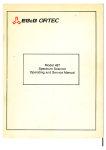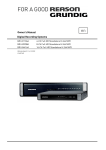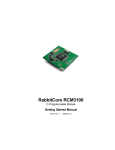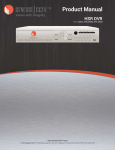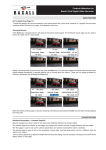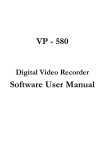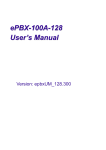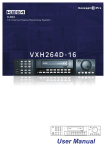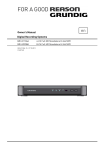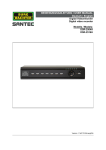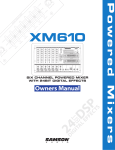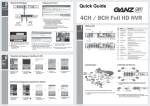Download NR4HLNR8HL User Manual
Transcript
1
CONTENT
OVERVIEW
PLAY
3
4
6 7
8
62
Before Installation
Key Features
Front Panel
Rear Panel
Remote Control At a Glance
If you want to play
INSTALLATION
ARCHIVING
10
11
65
Basic Layout
Connecting to an external devices
To start the Archive menu
MONITORING
WEB VIEWER
18
20
68
70
74
76
Start up/Shutdown
Live Screen At a Glan
What is the Web Viewer?
Live
Search
Setup
SYSTEM SETTING
MOBILE VIEWER
26
27
30
33
34
36
39
43
45
88
To move to the System Setup menu
Camera Setting
Display Setting
Audio Setup
User Setting
Network Setup
System Setting
Storage
Event Setup
GanzView
RECORD SETTING
ARCHIVE VIEWER
52
52
99
100
To start the Record Setup menu
Record Setup
Getting started with the Backup Play
Backup Player At a Glance
SEARCH
APPENDIX
58
103
58
59
To move to the Search menu while
in monitoring
To move to the Search menu while
in playback mode
Search Settings
Specification
᧮
OVERVIEW
Before installation
Comply with the following instructions to prevent a fire, explosion, system failure shock. or electric
Remove the power supply module before proceeding.
Check the input voltage (AC100VದAC240V) to the power supply module before connecting it.
Keep the product away from humidity.
Ensure that all devices connected to the product should be properly earth-grounded.
In operation mode
Comply with the following instructions to prevent a fire, explosion, system failure or electric
If you need to open the cover, consult with a service person who could help you do what you
want to do.
Do not connect multiple devices to a single power socket.
Keep the product away from dust or too much combustible substances (ex: propane gas).
Do not touch it with wet hand.
Do not insert a conductor in the vent of the ventilation system.
Do not apply excessive force to unplug the power cord.
Disassembly & Cleaning
When cleaning on the surface, use a dry cloth.
Do not wipe the product using water, paint thinner or organic solvents.
Do never dismantle, repair or modify the product by your own.
During installation
To prevent an accident or physical injury and to operate NVR properly, please comply with the
followings
Secure at least 18 centimeter of distance between cooling fan and wall for a proper ventilation.
Install the product on a flat surface.
Keep it away from direct sunlight or excessive temperature.
While in use
Do not apply force to or shake it while using it.
Do not move, throw away or put excessive force to it.
Using any unrecommended HDD may cause a system failure. Check the compatibility list and
use only compatible HDDs.
{A system failure or data loss caused by an incompatible HDD will void your warranty.}
᧯
OVERVIEW
Key Features
This product allows you to receive audio and video signals from a max of 4/8 CH 1080p H.264
network camera before
saving them to the internal HDD. Besides, you can also transfer them to an external device that can
be monitored on your PC
or mobile phone remotely
Display the video from up to 4/8 CH 1080p network camera in real time (Max 120/240 fps)
Save the video from up to 4/8 CH 1080p network camera in a max of 32/64Mbps (8Mbps
per channel) (Max 120/240fps)
Play up to 4/8 CH 1080p video in real time (Max 120/240 fps)
H.264 BP/MP/HP network camera supported(BP: Baseline profile, MP: Main profile, HP:
High profile)
4/8 built-in port, PoE switching hub (40W/72W)
ಫPlug & Play’ camera connection
Protect the IP camera via secured closed circuit LAN environment
Auto notification with self diagnosis (HDD S.M.A.R.T, temperature, network connection
status,fan error, etc.)
Dual streaming supported for a remote display
Auto resolution & FPS adjustment for a remote service
External eSATA HDD supported – various search methods (time, event, bookmark and
thumbnail)
Mass storage backup via USB port or FTP server
Dedicated smart phone applications that can be used with iPhone and iPad or on Android
OS
1080p Full HD GUI
᧰
OVERVIEW
What's included
Mouse DC 12V Adaptor
Adapter cable retainer clip x2
Remote Control x1
& Batteries (AAA x2)
DC 48V Adaptor
User manual CD
Power Cable x2
Screws
Quick Guide
᧱
OVERVIEW
Front Panel
Name
IR Remote
Control
Receiver
USB
Status LED
Description
Receive the signal from the remote control
Used for connecting USB storage or mouse.
Show the status of power,recording or network connection
together with the corresponding alarm.
᧲
OVERVIEW
Rear Panel
NO
Name
1
CAM1~CAM8
2
3
4
5
WAN(UPLINK)
AUDIO IN
ALARM OUT
RS-485
6
7
8
Power Switch
DC 12V
RS-232C
9
10
11
12
ALARM IN
AUDIO OUT
eSATA
HD MONITOR
13
LAN(DOWNLINK)
14
DC 48V
Description
Ethernet ports used for connecting the network camera video and
power.
Network port for connection to the Internet, router or hub
Microphone connection port.
Alarm output device connection port.
Communications port for connecting peripherals such as system
keyboard.
NVR power switch.Plug the power cord and turn this switch on.
NVR power input port Connect to a 12V adaptor.
Signal connection port for POS and ATM.Scheduled to be
upgraded.
Alarm input signal port.
Port for speaker connection.
Connection port for external SATA storage.
Port for connecting a full HD(1920x1080) supported monitor.
Use the HDMI cable to connect with a 1080p 60Hz monitor.
Port for connecting the dedicated network device. (Do not share with
other device.)
Power input port for the camera (PoE compliant).
Connect to a 48V adaptor.
᧳
OVERVIEW
Remote Control At a Glance
POWER
Turn on or off the power.
SEARCH
Display the search window.
ARCHIVE
Display the backup window.
Channel
Function as channel selection
button in live or playback mode.
Or used for entering the password.
DISPLAY
Switch the split mode.
SEQ
Switch to sequence mode.
SNAPSHOT
Turn on or off the power.
Used to change the direction
or adjust the play speed
in playback mode.
EXIT
Exit from the current screen
and return to the previous
screen.
ENTER
Select a menu item or apply
your settings.
LOGOUT
LOGOUT
PANIC
Start the emergency recording.
ALARM
Show the alarm status with
a popup window.
SETUP
Display the system setup menu.
ID
Set the remote control ID.
LOG
Display the log list.
KEYLOCK
Lock any operation on the unit.
AUDIO
Display the audio channel
Selection window.
RESERVE
Turn on or off the power.
MENU
Display the tool bar on the live
screen.
Use to move through the menus
PTZ/ZOOM
Enter the PTZ or digital zoom
Mode and control the operation.
᧴
OVERVIEW
Change the remote control ID
The remote control will be active only if the remote control ID matches with that specified on the
NVR.
If multiple NVRs are installed on one place and you have just a single remote control, use the ID
button to set the remote control ID. Only the ID-matching NVR can be controlled.
1.
2.
3.
4.
From <SYSTEM> - <CONTROL DEVICE> under the System Setup menu, set the
<REMOTE CONTROLLER ID> and press <Apply>.
Select between 00 and 99. For more details, refer to <SYSTEM SETUP>.
The remote control will be active only if the remote control ID matches with that of the
NVR's system ID.
Press the [ID] button on the remote control. The default remote control ID is 00.
Use the number buttons to provide a two-digit ID. If you want to enter 01, for instance,
enter the number 0 and 1 in sequence.
Check if the remote control ID is set properly by manipulating the remote control.
To reset the ID to 00, press and hold the [ID] button.
᧵
INSTALLATION
Basic Layout
Camera
Network CMS
Attached Web viewer
Storage Mobile viewer
Full HD
monitor
Speaker
MIC
eSATA
Storage
Sensor
Alarm
Control
Device
POS
ATM
Precautions
Access
Controller
To secure recording stability from an overloaded network traffic , hacking attempt or DoS (Denial
of Service) attack, only the direct cable connection between camera and NVR is allowed.
Any access from an outside PC to the IP camera will be strictly prohibited for the purpose of
secure operation.
9 Signal connection for POS and ATM is scheduled to be upgraded later.
᧭᧬
INSTALLATION
Connecting to an external device
Connecting to the monitor
This product supports only monitor models featuring 1080p 60Hz HDMI or DVI input.
Connect the HDMI cable between HDMI output port in the bottom rear panel and HDMI port of the
monitor, or use the
HDMI to DVI cable to connect to the DVI port of the monitor.
Power Connection
Two adaptors are provided: one for NVR operation (DC 12V), and the other for PoE (Power Over
Ethernet, DC48V).
NVR power connection
Plug the provided DC 12V adaptor in the rear power port of the NVR.
PoE Switching hub power connection
Plug the provided DC 48V adaptor in the rear power port of the NVR.
When done, attach the adaptor cable clip to the rear panel and insert the cable in.
Adaptor cable
retainer clip
DC48V adaptor
DC12V adaptor
Make connection when the power is not applied yet.
Arrange up the cables and be careful not to peel off the cable coating.
Do not place the power cord under the carpet or rug. The power cord is usually earthgrounded. However, even
if it's not earth-grounded, do never modify it on your own for earth-grounding.
Do not insert multiple devices in a single power socket. Otherwise, it may cause a power
overload.
For stable power supply, this product provides two separate adaptors and two
corresponding AC cords by factory default. Make sure all cables are connected properly.
᧭᧭
INSTALLATION
Connecting the camera
You can connect a PoE-featuring IP camera to the rear [CAM1]~[CAM8], RJ45 port using the CAT5
10/100Mb Ethernet cable without a separate power source.
Precautions
To secure recording stability from an overloaded network traffic , hacking attempt or DoS (Denial
of Service) attack, only the direct cable connection between camera and NVR is allowed.
9
If the IP camera provides the alarm I/O port or Audio I/O port, you can make alarm or
audio connection. For more details, refer to the user manual of the IP camera.
The Ethernet connection is effective within 100 meter in distance. Beyond that, you may
encounter a data loss or failure to connect to the camera. If you need to make cable
connection of longer than 100 meters, use a separate PoE extender for cable extension.
The total power consumption of the IP cameras should not exceed the rated power capacity
of the 48V PoE adaptor. Beyond that, the video may not be played properly or no video will
be displayed at all. If this is the case, use a separate (additional) power source for supplying
power to the cameras.
Camera
HUB or Router
NVR
For stable operation, a dedicated communication line is established for IP cameras in the
same network. This is why network router or hub connection is not allowed.
᧭᧮
INSTALLATION
Alarm I/O Connection
connect the alarm input signal
1. While pressing and holding the [A1] or [A2] port button in the rear bottom of the NVR,
insert the alarm signal cable in the hole under the button.
2. Insert the grounding wire in the [GND] port.
3. To ensure secure connection, release the button and pull out the wire to check if it's not
pulled out.
4. To remove the wire, pull it out while holding the upper button.
To connect the alarm output signal
Connect the signal line of an alarm output device to the rear [ALARM OUT] port.
1. Check the relay output type of Normal Open or Normal Close before selecting a proper
type (N/O or N/C). While holding the [N/O] or [N/C] button, arrange the alarm signal cable
through the hole under the button.
9 N/O(Normal Open) : normally Open but switching to Close if an alarm out occurs.
9 GND : Insert the grounding wire.
9 N/C(Normal Close) : normally Close but switching to Open if an alarm out occurs.
2. Insert the grounding wire in the [GND] port.
3. To ensure secure connection, release the button and pull out the wire to check if it's not
pulled out.
4. To remove the wire, pull it out while holding the upper button.
᧭᧯
INSTALLATION
Communication Port
RS-485 Connection
Connect the keyboard controller.
You can connect a text-in device such as POS or ATM. After connecting the control device, be sure
to match the connection settings between NVR and device. Make communication settings in
<Control Device>. (page 43)
1. Use the signal line to make connection between [D+] of the rear NVR and [D+] of the
keyboard controller.
2. Make connection between [D-] of the rear NVR and [D-] of the keyboard controller.
3. Connect [GND] on the rear of the NVR to [GND] of the keyboard controller.
9 For RS-485 connection, refer to the user manual of the keyboard controller.
9 Signal connection for POS and ATM is scheduled to be upgraded later.
RS-232 Connection
You can connect a text-in device such as POS or ATM.
For connection of the text-in device, refer to the user manual of the text-in device.
9 Signal connection for POS and ATM is scheduled to be upgraded later.
Audio Device Connection
You can connect an audio output device such as speaker amplifier.
Connect the audio input device such as microphone to the rear Audio In port, connect the audio
output device such as speaker amplifier to the Audio Out port.
᧭᧰
INSTALLATION
eSATA Storage
If the internal storage space is insufficient, you can extend your storage capacity by adding an
eSATA storage device to the rear eSATA port.
9
Recording may not be enabled with an incompliant eSATA storage. For the compatibility list,
contact the retailer of the eSATA storage.
USB Device
You can connect a USB storage device for saving the video, updating the firmware,
importing/exporting user data or settings. You can also connect the USB mouse to control all
operations of the NVR.
External HDD
(For backup only)
USB Storage
Mouse
If you need to connect a USB HDD with a high power consumption, it is recommended to
use a separate power source for that HDD.
᧭᧱
INSTALLATION
Network Connection
PC connection in the local network
You can connect NVR to a PC in the same network and control or manipulate it on the PC monitor.
Camera1
Camera2
Camera3
Camera4
Camera5
Camera6
Camera7
Broadband Router
Or
Hub
Camera8
Local PC
Local PC
1.
2.
Connect the [WAN(UPLINK)] port in the rear panel to the router or hub.
Connect the local PC to the router or hub.
Broadband Router or Hub
Local PC
3.
4.
5.
Local PC
Enter the address in the address bar (web browser) of the local PC or of the dedicated
software program in the format of ಯhttp://IP address:web service port ರ.(Ex : http://192.168.
1.23:8080) The web service port is set to 8080 by default. From the Network Setup screen,
you can change the port number.
Provide the ID and password before logging in. Then, you can view the monitoring screen.
Access ID (factory default) : ADMIN, P/W : 1234.
9 For the security purpose, change the password right after you purchased the product.
᧭᧲
INSTALLATION
PC connection from a remote network
You can connect NVR to a PC or mobile device in the same remote network and control or
manipulate it on the monitor of the PC or mobile device
Broadband Router
Direct Connection
ADSL Modem
Local PC
Local PC
Remote PC
Smart Phone
1.
Connect the [WAN(UPLINK)] port in the rear panel to the router.
Broadband Router
ADSL Modem
2.
3.
4.
Local PC
Connect the [WAN(UPLINK)] port of the router directly to the fixed IP LAN cable, or
connect it to the ADSL modem.
If using the router, set the port forwarding and enter the DDNS address in the address bar
(web browser) of the remote PC, or of the dedicated software program or mobile phone.
For the IP and DDNS address settings, refer to “Network Setup”. (page 37)
If the MAC address of the NVR is 00-1C-B8-12-34-56 and the web port number is 8080,
enter "http://001CB8123456.dvrlink.net:8080" in the address bar of the web browser.If you
have renamed DDNS as “mydvr”, you can make network connection
athttp://mydvr.dvrlink.net:8080
᧭᧳
Monitoring
Start Up/ Shutdown
START
You can connect NVR to a PC in the same network and control or manipulate it on the PC monitor.
1. Connect the adaptor to the 48V PoE power input
port in the rear panel of NVR.
9 Make connection when the power is not applied yet.
2. Connect the adaptor to the 12V power input port in
the rear panel of NVR.
3. Turn on the power switch in the rear panel of NVR.
With a beep, the logo screen appears several
seconds after the front LED turns on.
4. When the booting process is completed, the live
screen then the login screen appears.
Log In
To manipulate or access the menus of NVR, you should have logged in.
1. When the system starts, the login screen appears.
2. Select a user and provide the password.
The default password of the "ADMIN" account is
"1234".
3. Click <OK>.
If the login information is correct and valid, you will
see the live screen.
9 For the security purpose, change the password right
after you purchased the product.
.
Log Out
To prevent unauthorized access, it is recommended to log out when you leave the screen.
9 Hover the cursor near the bottom of the screen to display the menu.
1. In the monitoring screen, click <MENU> in the
bottom left corner of the screen to <LOG OUT>, or
press the [LOGOUT] button on the remote control.
2. 2Access to Search / Backup / System Setup /
Record Setup / System Shutdown will be restricted.
᧭᧴
Monitoring
System Shutdown
You can connect NVR to a PC or mobile device in the same remote network and control or
manipulate it on the monitor of the PC or mobile device
1. In the monitoring screen, click <Menu> in the
bottom left corner of the screen to <SHUTDOWN>
the system, or press the [POWER] button on the
remote control.
2. Use the virtual keyboard to enter the password.
3. Be sure to turn off the power switch in the rear
panel.
9 If you turn off the system in an abnormal manner
such as removing the power cord while the system
is in operation, the disk will have or increase the
bad sectors, causing data loss and shortened life cycle of the disk.
᧭᧵
Monitoring
Live Screen At a Glance
The live screen largely consists of three components: video window, status bar and timeline zone.
Video Window
Quick Menu
Timeline
Status Bar
Video Window
Icons used in the video window.
ITEM
Camera ID
Record Mode
Icons
Audio
I/O Icons
Motion
Detection
Icon
Description
Show the camera ID
Displayed if an event recording is reserved.
Display the status of the continuous recording.
Display the recording status when an alarm occurs.
Display the recording status when a motion event occurs..
Display the status of the emergency recording..
The audio signal of the connected camera is outputting.
The audio signal is transferring to the connected camera via the
microphone.
A motion is detected by the connected camera.
᧮᧬
Monitoring
Status Bar
Press the Ⴍ button on the remote control, or place the mouse in the lower area of the screen to
display the status bar.
ITEM
Menu Button
User ID
Screen
Control
Buttons
PTZ
Zoom
Quick Log
Audio
Channel
Selection
Button
Microphone
Channel
Selection
Button
Panic Record
Alarm Indicator
Network
Connection
Status
Disk Space
Date & Time
Description
Select one of the system setup, search and backup menu items
before accessing it.
Show the ID of the user who has currently logged in.
Change the screen layout so that both status bar and timeline are
displayed at all times.
Select a split mode.
Select Auto Sequence or Special Split Mode.
Display or hide the OSD menu on the screen.
Move to the PTZ screen. You can control the PTZ operations of a
PTZ-compliant camera on the PTZ screen.
Move to the Digital Zoom.
Display the log list of the recent recording events.
You can use the camera supporting the audio input to listen to the
audio.
Select a camera to which the audio signal will be transferred from the
connected microphone.
Start the panic recording.
Turns on if an event occurs. It does not turn on if no reaction to the
event is yet defined.
Click this to check the information of the event that occurred.
Check if network connection is made via an external PC or mobile
device. Click this to view the details of the concurrent users and to
check the network connection status. For more information, refer to
"Network Setup". (page 36)
Show the disk space information. If you have set the disk overwrite m
ode, it will be displayed "OW" (Over Write) from the start point of the
overwriting. Click this to viewthe details of the disk status. For more
information, refer to "Record Setup".
Display the current time and date.
Monitoring
Timeline
Press the [Ⴇ] button on the remote control or move the cursor to the right of the screen to display the
timeline. Double-click the timeline to move to the video screen. Drag and drop it to make backup or
event search for the specified area.
ITEM
Timeline Date
Expand/
Collapse
the timeline
Navigation
through
Timeline
Timeline Bar
Description
Display the date of the current timeline.
Click this to select a desired date of the timeline.
Expand or collapse the timeline.
Navigate through the timeline.
You can also use the mouse wheel to do the navigation..
Display the recording data with time. The color of each bar indicates
the following:
9 Green : Continuous Recording
9 Red : Alarm Recording
9 Blue : Motion Recording
9 Yellow: Panic Recording
Quick Menu.
ITEM
Channel No
Play
Zoom
Snapshot Capture
Audio ON/OFF
Microphone ON/OFF
Description
Display the number of the current channel.
Start playing the video of the selected channel from the specified time.
Zoom the video of the selected channel.
(Supported later)
Turn on or off the audio signal of the selected channel.
Turn on or off the microphone signal of the selected channel
᧮᧮
Monitoring
Using the status bar in the live mode
Selecting a split mode
Click a desired split mode from 1, 4, 9, 6 and 8 split screen. Or press the [DISPLAY] button on the
remote control until a desired split mode is displayed.
9 4CH NVR model support only 1- and 4-split screen modes.
Auto sequence
Click the Sequence button in the status bar, or press the [SEQ] button on the remote control to
perform the specified sequence mode.
You can configure the sequence settings in
<SEQUENCE>.
For details, refer to ಯSequenceರ. (page 31)
Zooming
You can enlarge the monitoring screen for better view.
Zooming will enlarge the video of the selected channel. If no channel is selected, channel 1 will be
zoomed.
1. Click Zoom in the status bar or move the cursor
to a desired channel and right-click it to display
the context menu. Select <ZOOM>.
You can also press the [ZOOM] button on the
remote control.
2. Move to the zoom control screen. When the
menu bar appears in the right bottom, use the
buttons to control the zooming.
Select a channel to zoom in/out.
Zoom out the current (enlarged) image step by step.
Enlarge the current image step by step.
Zoom Box : Use the yellow box to move to or select a desired zooming area.
Exit the zooming screen and return to the live screen.
᧮᧯
Monitoring
To check the event log
You can check the log of the events that occurred.
1. Click Log to display the “EVENT LOG” window.
The log list is sorted with the latest one on top.
2. Double-click a desired log to display the event
video.
You will move to the play screen of the selected
log.
To select an audio input channel
Select a channel from which the audio signal will be
received.
If you check the <LINK TO FULL SCREEN> option
and change the 1-split screen, the audio signal will be
sync with the selected channel.
9
Even if a channel to syn with is already selected,
checking the <LINK TO FULL SCREEN>
optionwill receive the audio signal only from the
selected1-split screen regardless of the previous
setting.
To select an audio output channel
You can select a camera outputting the voice signal
from the microphone that is connected to NVR.
᧮᧰
Monitoring
To check the alarm status
You can check the alarm status of each camera.
Click <OK> to close the window
To check the network status
You can check the network connection status.
Click <OK> to close the window.
9 For more information, refer to "Network Status".
(page 38).
To check the disk status
You can check the storage space of the current disk
and check also if there is any problem with the disk.
Click <OK> to close the window.
For more information, refer to "Disk Information".
(page 43).
᧮᧱
System Setting
To move to the System Setup menu
How to use the mouse
How to use the remote control 1
How to use the remote control 2
.
᧮᧲
System Setting
Camera Setting
You can configure the camera settings on the NVR screen regarding the camera ID, image,
hide/show, and motion.
CAMERA ID
You can change the camera ID that is displayed on
the screen.
1. From <SYSTEM SETUP> - <CAMERA>, select
<CAMERA TITLE>.
2. Use the [ʆʈُٙ/ENTER] buttons on the remote
control or use the mouse to select a channel that
you want to rename.
Alternatively, simply double-click the camera to
rename from the top left corner.
3. With the virtual keyboard that appears, enter a
camera title and click <OK>.
4. To apply the change, click <APPLY> in the bottom
of the screen.
5. When done, press the [EXIT] button on the remote
control or click <CLOSE> in the lower screen.
The confirmation message appears and you will
return to the previous menu.
Image Setup
Adjust the brightness, contrast, color and quality for
each channel to your preference. 1. From <SYSTEM
SETUP> - <CAMERA>, select <IMAGE SETUP>.
2. Use the [ʆʈُٙ/ENTER] buttons on the remote
control or use the mouse to set each option of the
image menu.
᧮᧳
System Setting
3. Click <ADVANCED> and configure the display
settings in detail for each camera as necessary.
9
The advanced setting items may differ
depending on the camera model.
4. To apply the change, click <APPLY> in the
bottom of the screen.
5. When done, press the [EXIT] button on the remote
control or click <CLOSE> in the lower screen.
The confirmation message appears and you will
return to the previous menu.
It is advisable not to change the <ADVANCED>
settings once you completed the initial settings properly.
Covert Setup
You can set to hide the camera video so that
a specific user or user group can not view.
Set a channel(s) that you want to hide from a specific
user or user group.
1. From <SYSTEM SETUP> - <CAMERA>, select
<COVERT SETUP>.
2. Use the [ʆʈُٙ/ENTER] buttons on the remote
control or use the mouse to select a covert
channel(s) from a specific user group.
>ADMIN, MANAGER, USER : Set them to <ON>.
The selected channel will be hidden from the applicable user account.
>LOGOUT : Set it to <ON>. When the user logs out, the selected channel will not be displayed.
3. Select display title on live view screen for covert channel either “COVERT” or “NO VIDEO”
To activate this settings, user need to logoff then login NVR again.
4. To apply the change, click <APPLY> in the bottom of the screen.
5. When done, press the [EXIT] button on the remote control or click <CLOSE> in the lower
screen.
The confirmation message appears and you will return to the previous menu.
To change the covert settings from user group to user, move to the <USER> menu and make
necessary changes. (page 34)
Motion Sensor
Set the motion sensor of the camera so that it can
detect a motion event.
1. From <SYSTEM SETUP> - <CAMERA>, select
<MOTION SENSOR>.
2. Use the [ʆʈُٙ/ENTER] buttons on the remote
control or use the mouse to specify the use of each
option item.
> ACTIVATION : turn on or off the motion sensor.
> MOTION MARK: Set it to <On>.
The video window will display the motion mark if a motion is detected.
System Setting
> SENSITIVITY : Set the sensitivity level of the motion sensor to either Daytime or Nighttime.
> MINIMUM BLOCKS : Set the minimum number of blocks (that will be considered an event) to
Daytime or Night if a motion is detected in several blocks in the motion sensor area.
> AREA SETUP : Specify the motion detection area.
3. To apply the change, click <APPLY> in the bottom of the screen.
4. When done, press the [EXIT] button on the remote control or click <CLOSE> in the lower
screen. The confirmation message appears and you will return to the previous menu.
9 The above options such as <SENSITIVITY> and <MINIMUM BLOCKS> and how to set
the motion area may be restricted
9 depending on the specification of the connected camera.
Motion Area Setup
From the motion setup window, click <AREA SETUP> in the right corner to display the area setup
screen. Setting the motion area may differ depending on the camera model. Below is a typical
setting of the motion area.
1. Click <AREA SETUP> to move to the motion
area setup screen.
2. If using the remote control, press the [ENTER]
button to mark the current position.
3. Use the arrow buttons to move to a desired block
and press [ENTER]. The area setup will begin.
Then, use the arrow buttons to specify the area.
Alternatively, you can use the drag-and-drop
method to specify or release the area as using
mouse.
4. If you select the specified area again, it will be
released.
5. Press the [EXIT] button on the remote control or
right-click any area to display the popup window
as in the right picture.
6. From the popup window, move to and specify the
<SENSITIVITY> and <MINIMUM BLOCKS>
for the current channel.
> CHANNEL : select a channel that you specify
the sensitivity and minimum blocks for.
>SENSITIVITY : 1(Low) ~ 10(High) - The higher
the number is, the more higher the sensitivity
level becomes.
>MINIMUM BLOCKS : 1(High) ~ 10(Low) - The
lower the number is, the higher the sensitivity level becomes.
> DAYTIME SET : specify the time period that will be considered as daytime.
> DAYTIME : specify the <SENSITIVITY> and <MINIMUM BLOCKS> for the daytime.
> NIGHTTIME : specify the <SENSITIVITY> and <MINIMUM BLOCKS> for the nighttime.
Images recorded in a low contrast scene such as at night cause severe noise, triggering the motion
event too often.
If this is the case, reduce the nighttime sensitivity to a degree.
᧮᧵
System Setting
Display Setting
You can configure the display settings regarding the OSD menus, monitor and sequence.
OSD
Configure the settings for the time, title, boundary, icon and language that will be displayed on the
screen.
1. From <SYSTEM SETUP> - <DISPLAY>,
select <OSD>.
2. Use the [ʆʈُٙ/ENTER] buttons on the remote
control or use the mouse to set each option of the
OSD item.
> CAMERA TITLE : specify the display of the
camera title on the screen.
> RECORDING MODE ICON : specify the display
of the record mode icon on the screen.
> AUDIO ICON : specify the display of the audio
icon on the screen.
> STATUS BAR ON FULL SCREEN MODE : select to show or hide the status bar in full screen
mode.
- AUTO HIDE : place the cursor in the lower area of the screen to display the status bar.
If moving the cursor up, the status bar will disappear.
- ALWAYS ON : The status bar will be displayed at all times.
- 5 SEC ~1 MIN : If no mouse movement is detected for from 5 seconds to 1 minute, the status
bar will disappear.
> TIMELINE ON FULL SCREEN MODE : select to show or hide the timeline in full screen mode.
- AUTO HIDE : place the cursor in the right corner to display the timeline. If moving the cursor to
the left, the timeline will disappear.
- ALWAYS ON : The timeline will be displayed at all times.
- ALWAYS OFF : The timeline will not be displayed.
> BORDER LINE : specify the display of the cross-border between channels in a split mode
> BORDER COLOR : select a color for the border.
> USER NAME : specify the display of the currently logged-in users on the status bar.
> LANGUAGE : select a menu display language.
3. To apply the change, click <APPLY> in the bottom of the screen.
4. When done, press the [EXIT] button on the remote control or click <CLOSE> in the lower
screen. The confirmation message appears and you will return to the previous menu.
᧯᧬
System Setting
Monitor
If you change from monitoring mode to sequence, you will have to set the interval of the sequence.
1. From <SYSTEM SETUP> - <DISPLAY>, select
<MONITOR>.
2. Use the [ʆʈُٙ/ENTER] buttons on the remote
control or use the mouse to set a sequence interval
for auto mode to 1 through 60 seconds.
3. To apply the change, click <APPLY> in the bottom of
the screen.
4. When done, press the [EXIT] button on the remote
control or click <CLOSE> in the lower screen.
The confirmation message appears and you will
return to the previous menu.
Sequence
Select a split mode for the sequence, and also select a list of active items when the sequence is
performed.
1. From <SYSTEM SETUP> - <DISPLAY>, select
<SEQUENCE>.
2. Use the [ʆʈُٙ/ENTER] buttons on the remote
control or use the mouse to add a sequence or
change the settings of the existing sequence.
>ACTIVATION : Select a list that you want to
Activate the sequence for.
Only one list will become active.
>ADD : add a sequence.
3. To apply the change, click <APPLY> in the bottom of
the screen.
4. When done, press the [EXIT] button on the remote control or click <CLOSE> in the lower
screen. The confirmation message appears and you will return to the previous menu.
To add a sequence
1. Click <ADD> in the bottom of the screen.
2. When the "ADD" dialog appears, enter a title using
thevirtual keyboard.
3. Enter the name of the sequence and click <ADD>.
4. When the <ADD VIEW TYPE> dialog appears,
click <ADD>.
5. When the "SEQUENCE SETUP" dialog appears,
Selecta split mode that you want to add from
<VIEW TYPE>.
᧯᧭
System Setting
6. If the selected split mode is CONFIRMATION displayed on <VIEW >, select a channel you want
to display in each split screen.
7. Click <OK>.
The set sequence mode is confirmed and will be
added to the Add Sequence list in order
8. When done, click <CLOSE> in the bottom of the
screen.
After the sequence type is saved, you will return to
the previous screen.
9. Right-click on the new sequence, or press the
[ENTER] button on the remote control to edit or
delete it.
To edit a sequence
1. Select a sequence that you want to edit in the list.
2. The "EDIT" dialog appears.
3. Use the [ʆʈُٙ/ENTER] buttons on the remote
control or use the mouse to edit the selected
sequence.
>SEQUENCE TITLE : enter a new sequence name.
>ACTIVATION : specify the use of the sequence.
>MODIFY : change the settings of the sequence
mode.
>DELETE : delete the selected sequence list.
>CANCEL : cancel the changes.
4. Pressing the <EDIT> button will display the Edit Sequence window.
5. To change the existing settings, select a screen mode that you want to edit and right-click to
display the context menu. Then, select <EDIT>.
6. When done, click <CLOSE> to close the window.
7. To apply your changes, click <APPLY>.
᧯᧮
System Setting
Audio Setup
You can configure the settings of the voice and audio signal.
AUDIO
Choose whether to receive the live sound source
and select an audio channel.
1. From <SYSTEM SETUP> - <AUDIO>, select
<AUDIO>.
2. Use the [ʆʈُٙ/ENTER] buttons on the remote
control or use the mouse to select an item that
youwant to edit.
>DEFAULT LIVE AUDIO CHANNEL : select an
Audio channel to monitor on the live screen.
>NETWORK AUDIO TRANSMISSION : decide if
NVR transfers the audio signal to the remote client.
>RECEIVE NETWORK AUDIO : decide if NVR receives the audio signal from the remote client.
3. To apply the change, click <APPLY> in the bottom of the screen.
4. When done, press the [EXIT] button on the remote control or click <CLOSE> in the lower
screen. The confirmation message appears and you will return to the previous menu.
Buzzer output
You can set to output the buzzer if you manipulate
the remote control.
1. From <SYSTEM SETUP> - <AUDIO>, select
<BUZZER>.
2. Use the [ʆʈُٙ/ENTER] buttons on the remote
control or use the mouse to select an item that you
want to edit.
> REMOTE CONTROL : specify the output of a beep
when you press a button on the remote control.
3. To apply the change, click <APPLY> in the bottom
ofthe screen.
4. When done, press the [EXIT] button on the remote control or click <CLOSE> in the lower screen.
The confirmation message appears and you will return to the previous menu.
᧯᧯
System Setting
User Setting
You can configure the settings regarding user management and user and group permissions.
Management
You can add a user account(s) that can be edited at
a later time.
1. From <SYSTEM SETUP> - <USER>, select
<MANAGEMENT>.
2. Use the [ʆʈُٙ/ENTER] buttons on the remote
control or use the mouse to add a user account or
select an item that you want to edit.
3. To apply the change, click <APPLY> in the bottom
ofthe screen.
4. When done, press the [EXIT] button on the remote
control or click <CLOSE> in the lower screen. The confirmation message appears and you will
return to the previous menu.
To add a user account
1. Click <ADD> in the bottom of the screen.
2. Use the [ʆʈُٙ] buttons on the remote control and
move to a desired item. Then, press [ENTER] to
select the item.
> USER ID : enter the user ID using the virtual
keyboard.
> PASSWORD : With the virtual keyboard, enter the
password.
> GROUP : From <ADMIN>, <MANAGER> and
<USER>, select a group that the user belongs to.
> EMAIL : Type in the e-mail address to which you will receive notification of an event if it occurs.
> EMAIL NOTIFY : Choose whether you will receive notification of an event if it occurs.
> COVERT CHANNEL : You can set the channel to hide from a specific user.
3. When done, click <OK>.
The added user account will be listed.
᧯᧰
System Setting
To edit the user account information
1. From the list of users, select a user account to edit
and click <EDIT> next to it.
2. From the Edit window, make necessary changes
and click <OK>.
3. To delete the user account, click <DELETE>.
The <ADMIN> account can not be changed
or edited.
.
Group Authority
You can grant different user groups different permissions to a specific menu.
1. From <SYSTEM SETUP> - <USER>, select
<GROUP AUTHORITY>.
2. Use the [ʆʈُٙ/ENTER] buttons or use the
mouse to set the permissions for both
<MANAGER>and<USER> groups.
>SEARCH : Set the permissions for the
Search menu.
>ARCHIVING : Set the permissions for the Backup
menu.
>SYSTEM SETUP : Set the permissions for the
System Setup menu.
>RECORD SETUP : Set the Access Permissions for the Record Setup menu.
>EVENT ACTION CONTROL : Set the permissions to output the alarm or control the buzzer if an
event such as alarm occurs.
>LISTEN TO AUDIO : Set the permission to listen to the audio.
>MICROPHONE : Set the permission to speak through the microphone.
>REMOTE LOG IN : Set the permission to access remotely.
>SHUTDOWN : Set the permission to shut down NVR from the System menu.
3. To apply the change, click <APPLY> in the bottom of the screen.
4. When done, press the [EXIT] button on the remote control or click <CLOSE> in the lower
screen. The confirmation message appears and you will return to the previous menu.
᧯᧱
System Setting
Network Setup
You can configure the settings regarding user management and user and group permissions.
IP Setup
Specify the IP address as well as the remote service
port.
1. From <SYSTEM SETUP> - <NETWORK>,
select <IP SETUP>.
2. Use the [ʆʈُٙ/ENTER] buttons on the remote
control or use the mouse to specify each item of the
network settings.
>DHCP : If it is checked, set the IP address of the
NVR to Dynamic IP.
- If the <DHCP> item is checked, the sub items
of IP address, gateway, subnet mask, primary DNS server, secondary DNS server will be filled
in automatically.
If you select to obtain an IP address from the <DHCP> server, when the lease time of the
DHCP server expires, you will lose connection to the IP camera momentarily while the network
settings will be updated. However, the network connection will be restored soon. It is
recommended to use a fixed IP for stable network connection.
>IP ADDRESS : Provide the IP address.
>GATEWAY : provide the gateway address.
>SUBNET MASK : provide the subnet mask address.
>1ST DNS SERVER : Enter the address of the primary DNS server.
>2ST DNS SERVER : Enter the address of the primary DNS server.
>RTSP SERVICE PORT : port number that the remote client receives the NVR video from.
>WEB SERVER PORT : port number used for connecting to the NVR with the web browser.
>PORT FORWARDING : If you are using a router, you can set the port forwarding so that external
access to the NVR is enabled.
If the router does not support the uPnP protocol, you must set the port forwarding manually.
For more information, contact your network administrator.
>DELETE PORT : release the port forwarding settings for the router.
>MAX TX SPEED : Limit the network transfer rate to access a remote client.
The video signal may be transferred at a less rate than specified, which depends on the status of
your network connection.
3. To apply the change, click <APPLY> in the bottom of the screen.
4. When done, press the [EXIT] button on the remote control or click <CLOSE> in the lower
screen. The confirmation message appears and you will return to the previous menu.
᧯᧲
System Setting
DDNS
You can configure the DDNS settings so that remote users who are connected to the network can
access remotely DDNS is an IP redirection service in a dynamic IP environment that redirects (maps)
the new IP address to a registered domain name
each time the IP address is changed.
1. From <SYSTEM SETUP> - <Network>, select
<DDNS>.
2. Use the [ʆʈُٙ/ENTER] buttons on the remote
control or use the mouse to specify the use of
DDNS and select a server.
>DDNS : Specify the use of DDNS connection.
>DDNS SERVER : Select a server to connect to.
>NVR NAME : Enter the name of the NVR that you
want to use as DDNS.
>DDNS REGISTRATION TEST : Check if the <NVR NAME> can be set as DDNS. If there is a
duplicate name in the server, the registration will fail. If this is the case, rename the
<NVR NAME> and press Test to check if it works properly.
>NVR ADDRESS : Provide the <NVR NAME> and press the <DDNS REGISTRATION
TEST> button. The name will be added automatically.
>DDNS CONNECTION TEST : Perform the connection test to check if DDNS is normally
registered.
3. To apply the change, click <APPLY> in the bottom of the screen.
4. When done, press the [EXIT] button on the remote control or click <CLOSE> in the lower
screen. The confirmation message appears and you will return to the previous menu.
Email
You can register and test an email address so that an email notification is delivered at a specific
interval or if an event occurs.
1. From <SYSTEM SETUP> - <NETWORK>,
select <EMAIL>.
2. Use the [ʆʈُٙ/ENTER] buttons on the remote
control or use the mouse to specify the use of email
and select a server.
>SERVER : Set up the mail server. Set the mail
Server that will be used for notification to the NVR.
Use the virtual keyboard to enter your mail server.
>PORT : Enter the mail server port.
>SECURITY : If it is set to <On>, the email will be transferred in secure mode.
If it is set to <Off>, the email will be transferred to a server that does not support SSL.
>USER : Provide the email account (ID) of the sender.
>PASSWORD : Provide the password of the sender.
>TEST EMAIL ADDRESS : Enter an email address for the test purpose.
>TEST : Send a test email and check if the test email is delivered normally.
3. To apply the change, click <APPLY> in the bottom of the screen.
4. When done, press the [EXIT] button on the remote control or click <CLOSE> in the lower
screen. The confirmation message appears and you will return to the previous menu.
᧯᧳
System Setting
Network Status
From the network map screen, you can check the internet connection status and IP camera connecti
on status, and check also the details of the
connection status for each camera.
1. From <SYSTEM SETUP> - <NETWORK>,
select <NETWORK STATUS>.
2. Use the [ʆʈُٙ/ENTER] buttons on the remote
control or use the mouse to select one between
<NETWORK MAP> and <DETAIL STATUS>.
3. When done, press the [EXIT] button on the
remote control or click <CLOSE> in the lower
screen.
The confirmation message appears and you will
return to the previous menu.
Network Map
> IP ADDRRESS : Indicates the internal IP address
of the NVR.
> MAC ADDRESS: Indicates the internal MAC
address of the NVR.
>DDNS ADDRESS: Indicates the internal DDNS
address of the NVR.
>RTSP SERVICE PORT : Indicates the network
port of the video service.
For remote service, the router must have set up the port forwarding.
>WEB SERVICE PORT : Indicates the web service network port.
For the remote service to be enabled, the corresponding port of the router should have set
up the port forwarding.
>DDNS UPDATE STATUS : Shows if the DDNS address was registered to the DDNS server
normally. Press < > to try to register the DDNS address forcibly.
>EXTERNAL IP ADDRESS : Indicate the IP address for the internet, accessible from the NVR.
The NVR can be granted access with the web browser at http://<External IP Address>:<Web
Service Port>. The IP address can vary in a dynamic IP environment.
>CONNECTED CLIENTS :Shows the list of clients that are currently connected.
Press < > to terminate the connection of an unwanted client forcibly.
Termination is limited to only users in a lower group than the current user.
Detail Status
You can check the details of the cameras that are
connected to each channel.
Click < > in the right area of the list to show the
details. Click <RESET> in the “IP CAMERA
CONFIGURATION” window to reset the IP camera.
When the IP camera settings are complete,
click <OK>.
᧯᧴
System Setting
System Setting
You can configure the settings of date/time, system management, and keyboard controller.
Date/Time
Specify the current date and time.
1. From <SYSTEM SETUP> - <SYSTEM>, select
<DATE/TIME>.
2. Use the [ʆʈُٙ/ENTER] buttons on the remote
control or use the mouse to change the time or set
the options as necessary.
>DATE/TIME : Set the current time and date.
Click< > to adjust the time manually.
>DATE FORMAT : specify the date format.
>TIME FORMAT : specify the time format.
>TIME SERVER : obtain the current time from the
time server. Click < > to get the current time.
>AUTO TIME SYNC : automatically synchronize the
time with the time server at a specific time.
>SYNC AT : Set the time to sync with the time
server.
>TIMEZONE : specify the GMT standard time for
your local area.
>DST : You can set up or release the DST (Daylight
Saving Time).
3. To apply the change, click <APPLY> in the bottom of the screen.
4. When done, press the [EXIT] button on the remote control or click <CLOSE> in the lower
screen. The confirmation message appears and you will return to the previous menu.
᧯᧵
System Setting
System Management
You can check, update or reset the system information.
1. From <SYSTEM SETUP> - <SYSTEM>, select
<SYSTEM MANAGEMENT>.
2. Use the [ʆʈُٙ/ENTER] buttons on the remote
control or use the mouse to set each option of the
system management.
FW UPDATE : you can update the current
software with the latest version.
FACTORY DEFAULT : Return the NVR settings to
the factory default.
SYSTEM DATA : Save the system settings or get
the system information from other device.
- SAVE : Store the NVR settings to a storage device.
Connect the storage device to the USB port of NVR.
- LOAD : Apply the settings of the storage device
to the NVR. Connect the storage device to the
USB port of NVR.
PASSWORD : Open or close the dialog box for
settings of the menus: quit, system settings, record
settings, backup, and search.
If it is set to <Off>, note that the ADMIN account is
only effective and access to all menus will be
restricted.
EXPIRED TERM OF PASSWORD : You will be
prompted to change the current password after a
certain period of time.
AUTO LOGOUT : If there is no user input for a
certain period of time, you can set to log out
automatically.
WAIT TIME : Specify the waiting time for Auto
Logout.
AC POWER FREQUENCY : Select AC power
Frequency of your area.
60Hz : maximum frame rate will be set to 30fps
50Hz : maximum frame rate will be set to 25fps
If you have a flicker on the image, select suitable
the frequency.
3. When done, press the [EXIT] button on the
remote control or click <CLOSE> in the lower screen
to return to the previous menu.
᧰᧬
System Setting
To perform the upgrade
1. Connect the USB storage device that contains the
updatable files.
2. Click <USB>.
3. Select one(s) from the updatable files LIST listed
in <F/W >.
4. Click <UPGRADE>.
5. When the confirmation message appears, click
<OK>.
6. The progress bar displays the progress of the
firmware upgrade process.
7. When the upgrade is complete, reboot the system. ᧰᧭
System Setting
System Information
You can check the current system version and system-related settings.
1. From <SYSTEM SETUP> - <SYSTEM>, select
<SYSTEM INFORMATION>.
2. Check the status of the current system.
3. When done, press the [EXIT] button on the remote
control or click <CLOSE> in the lower screen.
The confirmation message appears and you will
return to the previous menu.
Control Device
Configure the settings of the remote control and
keyboard controller.
1. From <SYSTEM SETUP> - <SYSTEM>, select
<CONTROL DEVICE>.
2. Use the [ʆʈُٙ/ENTER] buttons on the remote
control or use the mouse to set the connection
options for the control device.
>SYSTEM ID : Set the ID of the NVR so that the
keyboard controller can identify.
>PROTOCOL : Set up the protocol of the keyboard
controller.
>BAUD RATE : Specify the RS485 communication speed.
>REMOTE CONTROLLER ID : Set the ID of the remote control.
3. To apply the change, click <APPLY> in the bottom of the screen.
4. When done, press the [EXIT] button on the remote control or click <CLOSE> in the lower
screen. The confirmation message appears and you will return to the previous menu.
᧰᧮
System Setting
Storage
You can configure the settings of and view information of the disk and external storage device.
Disk Information
It will show information about the connected disk.
1. From <SYSTEM SETUP> - <STORAGE>,
select <DISK INFORMATION>.
2. Use the [ʆʈُٙ/ENTER] buttons on the remote
control or use the mouse to select either
<INTERNAL > or <EXTERNAL STORAGE>.
Please check the status for each connected device.
>START / END TIME : show the start time and end
time of data stored in each disk.
>STATUS : check if the connected disk is being
used by the NVR. If you encounter a problem with
the disk, the NVR will terminate the connection to
the disk and mark it as ಫNot In Useಬ.
>CAPACITY : show the capacity of the disk.
>MODEL : indicate the disk model.
>S.M.A.R.T STATUS : Read the S.M.A.R.T
information of the disk and check to display if the
current disk is in normal operation.
- NORMAL : The disk is in a normal state.
- CHECK : The disk has an error so that you need to check the disk or the connection cables of
the disk.
If you leave the problem unresolved, no recording may be enabled.
So it is recommended that you replace the disk immediately.
- ERROR : The disk fails or is unable to use due to an error of the disk or the cable.
The disk should be replaced immediately. Contact the retailer or the customer service to replace
the disk.
3. When done, press the [EXIT] button on the remote control or click <CLOSE> in the lower
screen to return to the previous menu.
᧰᧯
System Setting
Disk Operations
You can set to delete the recording automatically and set the overwrite options, and you can also
format the HDD
recording data.
1. From <SYSTEM SETUP> - <STORAGE>,
select <DISK OPERATIONS>.
2. Use the [ʆʈُٙ/ENTER] buttons on the remote
control or use the mouse to set the operation
conditions of the disk.
>DISK WRITE MODE
- If it is set to <OVERWRITE>, the existing data
will be overwritten by new recording data if the
recording data size exceeds the free space of the HDD.
- If the option is set to <ONCE> and the HDD is full, the NVR will stop recording and output the
beep or alarm that is pre-defined at <EVENT>.
>RECORDING TIME LIMIT : The recording data will be deleted after a specific time of
reservation. If it is set to <OFF>, this function will be disabled.
>DISK FORMAT : format the hard disk.
Note that formatting the HDD will delete all video data and logs.
3. To apply the change, click <APPLY> in the bottom of the screen.
4. When done, press the [EXIT] button on the remote control or click <CLOSE> in the lower
screen. The confirmation message appears and you will return to the previous menu.
S.M.A.R.T settings
You can check the S.M.A.R.T information of the disk and specify the check frequency.
9 What is S.M.A.R.T information?
9 S.M.A.R.T (Self-Monitoring, Analysis and Report Technology) is to detect a HDD that is likely to
cause a problem in the future with a warning message.
1. From <SYSTEM SETUP> - <STORAGE>,
select <S.M.A.R.T. SETUP>.
2. Use the [ʆʈُٙ/ENTER] buttons on the remote
control or use the mouse to check the S.M.A.R.T
operation and specify the check interval.
>S.M.A.R.T STATUS : Read the S.M.A.R.T
information of the disk and check to display if the
current disk is in normal operation.
Click <DETAIL INFO> to view the details of the
remote control and keyboard controller.
- NORMAL : The disk is in a normal state.
- CHECK : The disk has an error so that you need to check the disk or the connection cables of
the disk. If you leave the problem unresolved, no recording may be enabled.
So it is recommended that you replace the disk immediately.
- ERROR : The disk fails or is unable to use due to an error of the disk or the cable. The disk
should be replaced immediately. Contact the retailer or the customer service to replace the disk.
᧰᧰
System Setting
9
S.M.A.R.T CHECK INTERVAL : Specify the S.M.A.R.T check interval. Click <CHECK NOW>
to start checking.
3. To apply the change, click <APPLY> in the bottom of the screen.
4. When done, press the [EXIT] button on the remote control or click <CLOSE> in the lower
screen. The confirmation message appears and you will return to the previous menu.
Event Setup
Define various events, and specify the conditions to notify the user in various ways.
Alarm Out
Specify the alarm output conditions with the work schedule.
Alarm Out
1. From <SYSTEM SETUP> - <EVENT>, select
<ALARM OUT>.
2. Use the [ʆʈُٙ/ENTER] buttons on the
remote control or use the mouse to select
<ALARM OUT>and configure the related settings.
>NAME : You can rename the alarm.
>OPERATION : Set the alarm output mode.
- N/O (Normal Open) : It normally stays Open.
However, if an event occurs, it will switch to Close.
- N/O (Normal Close) : It normally stays Close.
However, if an event occurs, it will switch to Open.
>DURATION : Specify the duration of the alarm output.
- TRANSPARENT : Keep the alarm out for as much time as the event lasts.
- UNTIL KEY : Keep the alarm out until a mouse or remote control button is pressed.
- 5 ~ 300 SEC : Keep the alarm out for as long as specified.
>TEST : Forcibly output the alarm for the test purpose.
3. To apply the change, click <APPLY> in the bottom of the screen.
4. When done, press the [EXIT] button on the remote control or click <CLOSE> in the lower
screen. The confirmation message appears and you will return to the previous menu.
᧰᧱
System Setting
ON/OFF Schedule
You can activate or turn off the alarm output as
scheduled.
1. Use the [ʆʈُٙ/ENTER] buttons on the remote
control or use the mouse to select a <DATE> for the
schedule.
2. Drag the mouse to resize the cell or use the on the
[ʆʈُٙ] buttons to move to the cell, then press
[ENTER].
3. Select a desired alarm output mode.
>ON : The alarm output is always turned on.
>OFF : The alarm output is always turned off.
>EVENT : Trigger the alarm output in sync with the
event.
4. Click <COPY SCHEDULE> to check the checkbox
of the date that you want to copy the schedule at.
5. When done, click <OK> to apply the settings.
6. To apply the change, click <APPLY> in the bottom
of the screen.
7. When done, press the [EXIT] button on the remote
control or click <CLOSE> in the lower screen.
The confirmation message appears and you will return to the previous menu.
Event Notification
Specify the methods of notification such as buzzer, video popup or email if an event occurs.
1. From <SYSTEM SETUP> - <EVENT>, select <EVENT NOTIFICATION>.
2. Use the [ʆʈُٙ] buttons on the remote control or use the mouse to select one from <BUZZER>,
<DISPLAY> and <EMAIL>.
3. Use the [ʆʈُٙ/ENTER] buttons on the remote control or use the mouse to set the output
method and duration.
4. To apply the change, click <APPLY> in the bottom of the screen.
5. When done, press the [EXIT] button on the remote control or click <CLOSE> in the lower
screen. The confirmation message appears and you will return to the previous menu.
᧰᧲
System Setting
Buzzer output
You can notify the user of the event using the buzzer.
>DURATION
- TRANSPARENT : Keep the buzzer out for as
much time as the event lasts.
- UNTIL KEY : Keep the buzzer out until a mouse
or remote control button is pressed.
- 5 ~ 300 SEC : Keep the buzzer out for as long
as specified.
Display
If an event occurs, you can display the video screen or a popup message to notify the user of the
event.
>VIDEO POPUP : Display the video channel that is synchronized with the event on a single split
screen. Set the DURATION of the single split screen.
- TRANSPARENT : Keep the video popup
displayed for as much time as the event lasts.
- UNTIL KEY : Keep the video popup displayed
until a mouse or remote control button is pressed.
- 5 ~ 300 SEC : Keep the video popup displayed
for as long as specified.
If multiple events occur at the same time, or if
multiple event-related video channels exist, the
video popup will be displayed in the maximum
split screen mode rather than the single split
screen mode.
>OSD POPUP : This will notify the user of the event with a popup message if an OSD popup
event occurs.
You can adjust the duration of the popup message.
- UNTIL KEY : Keep the OSD popup displayed until a mouse or remote control button is pressed.
- 5 ~ 300 SEC : Keep the OSD popup displayed for as long as specified.
᧰᧳
System Setting
Email
If an event occurs, this will notify registered users of the event by email. If you do not want to receive
the email, uncheck the <EMAIL NOTIFY> option in <MANAGEMENT>. (Page 34)
>ADD NEW EMAIL
If you want to add a new mail recipient beside the
existing ones, click this to add the recipient.
>MINIMUM EMAIL FREQUENCY
Adjust the minimum frequency of sending the email.
For example, even if you have set the minimum
frequency to one minute and another event occurs
in less than one minute after the last email sending,
the email for the new event will be sent one minute
after.
Some email servers can block the email sending
if the email delivery cycle is too short, and
classify it as spam.
Contact your email service provider to adjust the minimum delivery cycle so that the server does
not classify the email as spam.
Alarm Sensor
You can configure the settings of the alarm sensor and specify the operation of the sensor if an
event occurs.
1. From <SYSTEM SETUP> - <EVENT>, select
<ALARM SENSOR>.
2. Use the [ʆʈُٙ] buttons on the remote control or
use the mouse to specify the sensor input method
and operation.
>NAME : You can specify the name of the alarm
sensor.
>OPERATION : You can specify the type of the
alarm sensor.
- N/O (Normal Open) : Normally the sensor is left
Open. If the sensor switches to Close, an event will be triggered.
- N/C (Normal Close) : Normally the sensor is left Close. If the sensor switches to Open,
an event will be triggered.
>LINKED CAMERA : Set the camera to sync with the alarm sensor if it is triggered.
If you have set the alarm recording and the sensor detects the recording, all synchronized
cameras will start alarm recording.
>ALARM OUTPUT : Specify the alarm output channel if it is detected by the alarm sensor.
The alarm will be output to the specified channel.
>BUZZER : Specify the output of the buzzer if an alarm is detected by the alarm sensor.
>VIDEO POPUP : Select to display the video popup if an alarm is detected by the alarm sensor.
If there exist multiple <LINKED CAMERA>, the video popup will be displayed in the maximum
split mode.
>OSD POPUP : Select to display the OSD popup message if it is detected by the alarm sensor.
>EMAIL : Select to send an email if detected by the alarm sensor.
3. To apply the change, click <APPLY> in the bottom of the screen.
4. When done, press the [EXIT] button on the remote control or click <CLOSE> in the lower
screen. The confirmation message appears and you will return to the previous menu.
᧰᧴
System Setting
Motion Sensor
You can set an action to execute when a motion is detected.For the settings of the motion sensor,
move to <CAMERA SETUP>.
1. From <SYSTEM SETUP> - <EVENT>, select
<MOTION SENSOR>.
2. Use the [ʆʈُٙ] buttons on the remote control
or use the mouse to specify the ignorance interval
and operation.
>IGNORING INTERVAL : Specify the minimum
interval of the motion event occurrence.
For example, even if you have set the minimum
frequency to 5 seconds and another motion event
occurs in less than 5 seconds after the last motion
event occurred, the new event will be ignored.
If too many motion events occur, adjust to shorten the interval.
9
Motion recording will be triggered immediately after the motion occurred regardless of the
above settings.
>ALARM OUTPUT : Specify the alarm output channel if a motion is detected by the motion sensor.
>BUZZER : Specify the output of the buzzer if a motion is detected by the motion sensor.
>VIDEO POPUP : Select to display the video popup if a motion is detected by the motion sensor.
>EMAIL : Select to send an email if a motion is detected by the motion sensor.
3. To apply the change, click <APPLY> in the bottom of the screen.
4. When done, press the [EXIT] button on the remote control or click <CLOSE> in the lower
screen. The confirmation message appears and you will return to the previous menu.
Video Loss
You can specify a reaction to the case where no video is received from the camera.
1. From <SYSTEM SETUP> - <EVENT>, select
<EVENT LOSS>.
2. Use the [ʆʈُٙ] buttons on the remote control
or use the mouse to specify the reaction to a
video loss.
>ALARM OUTPUT : Specify the alarm output
channel if a video loss occurs.
>BUZZER : Specify the output of the buzzer if a
video loss occurs.
>EMAIL : Select to send an email if a video loss
occurs.
3. To apply the change, click <APPLY> in the bottom of the screen.
4. When done, press the [EXIT] button on the remote control or click <CLOSE> in the lower
screen. The confirmation message appears and you will return to the previous menu.
᧰᧵
System Setting
System Event
You can set any action to an event related to the disk, recording, network or system. Like the other
events, you may notify the event to the user using the alarm/buzzer output, OSD pop-up or email.
1. From <SYSTEM SETUP> - <EVENT>, select <SYSTEM EVENT>.
2. Use the [ʆʈُٙ] buttons on the remote control or use the mouse to specify the reaction to each
event.
3. To apply the change, click <APPLY> in the bottom of the screen.
4. When done, press the [EXIT] button on the remote control or click <CLOSE> in the lower
screen. The confirmation message appears and you will return to the previous menu.
Disk
>OVERWRITE START EVENT : if you set the disk
write mode to <OVERWRITE>, this event occurs
when the disk is full and the overwriting begins
accordingly.
>DISK FULL EVENT : if you set the disk write mode
to <ONCE>, this event occurs when the disk is full
(100%).
>DISK SPACE EXHAUSTED EVENT : Event that is
triggered if the disk is almost full.
Click to specify the threshold percentage of usage
to trigger the event.
>S.M.A.R.T EVENT : Occurs if the disk causes the S.M.A.R.T error.
>NO DISK EVENT : Occurs if no disk is recognized after the booting due to a disk failure or cable
problem.
To detect the disk error, it is recommended not to change the settings of the S.M.A.R.T event, no
disk event and buzzer output.
Record
>PANIC RECORD START EVENT : Specify the
action to perform when the panic recording begins.
᧱᧬
System Setting
System
>BOOTING EVENT: This event occurs when the
NVR is booting.
>LOGIN FAIL EVENT: This event occurs when the
NVR fails to log in.
You can specify the times of clicking < > to
trigger the event.
>FAN ERROR EVENT : This event occurs if the CPU
cooling fan or unit's cooling fan does not work at all.
If the fan fails, no recording will proceed by the NVR.
If you encounter a fan failure, contact the retailer or
the service enter for technical assistance.
>TEMPERATURE FAIL EVENT : This event occurs if the internal temperature of the NVR exceeds
the effective range. Then, the NVR will not operate normally. If this is the case, check the
followings and take a necessary measure.
- Check if the ventilation of the NVR is clogged with foreign substances. If so, remove them.
- Keep the NVR away from a heat source such as heater. Install it in a flat, lower area with good
ventilation.
- If the problem persists, contact the retailer or service center.
To monitor the normal operation of the NVR, it is recommended not to change the buzzer output
settings of the fan failure event and the temperature fail event.
Network
>TROUBLE IN INTERNET CONNECTION : Occurs
if the Internet connection to the NVR fails.
If you do not want to connect the NVR to the
network, leave the <Action> item blank.
>FAIL IN REMOTE LOGIN : This event occurs if a
remote client fails to log in due to an invalid ID or
password.
You can specify the times of clicking < > to
trigger the event.
>FAIL IN DDNS UPDATE : This event occurs if the
NVR tried to update the DDNS address but failed.
9 If the DDNS address fails to be updated,the NVR may not connect to a remote client.
If this is the case, enter the IP address from the client side to allow access from the NVR.
This is just a temporary measure.
For the IP address, move to and check <EXTERNAL IP ADDRESS> from the
<NETWORK> window. Note that the <EXTERNAL IP ADDRESS > is subject to change if
the NVR does not use the static IP.
Note that the <EXTERNAL IP ADDRESS> can change at any time in a dynamic IP
environment.
᧱᧭
Record Setting
You can configure the record settings for the NVR. Only authorized users can access the Record
Setup menu.
To start the Record Setup menu
How to use the mouse
How to use the remote control 1
Record Setup
Operation Mode
You can set the recording options for Auto or Manual mode.
1. From <RECORD SETUP> menu, select <OPERATION MODE>.
2. Use the [ʆʈُٙ] buttons or use the mouse to set <RECORD SETUP MODE> to
<AUTO CONFIGURATION> or<MANUAL CONFIGURATION>.
3. Set the recording options for each selected Record mode.
4. To apply the change, click <APPLY> in the bottom of the screen.
5. When done, press the [EXIT] button on the remote control or click <CLOSE> in the lower
screen. The confirmation message appears and you will return to the previous menu.
.
᧱᧮
Record Setting
Auto Configuration
If you choose your preferred record mode, the NVR will recommend you the optimized settings for
the selected record mode.
>ALWAYS HIGH VIDEO QUALITY : Recording will proceed in the best quality regardless of the
event at all times.
As this option will always make recording in the
best quality, the recording period is the shortest
compared to the other record modes.
>MOTION RECORD : Recording will proceed only
if a motion is detected.
>ALARM RECORD : Recording will proceed only
if an alarm event occurs.
>MOTION/ALARM RECORD : Recording will proceed
only if a motion is detected or an alarm event occurs.
>INTENSIVE MOTION RECORD : Normally
recording will be performed in a low quality. However, the quality will switch to high if a motion is
detected.
>INTENSIVE ALARM RECORD : Normally recording will be performed in a low quality. However,
the quality will switch to high if an alarm event occurs.
>INTENSIVE MOTION/ALARM RECORD : Normally recording will be performed in a low quality.
However, the quality will switch to high if an alarm event occurs or a motion is detected.
Manual Configuration
If you set the record mode to <MANUAL CONFIGURATION>, the manual configuration window will
appear where youcan set the manual recording
and panic recording options.
>MANUAL CONFIGURATION OPTIONS : You can
configure the recording settings by the time, date,
and channel.
- SCHEDULE MODE : Set the recording
schedule for a day (daily) or for a week (weekly).
- PRE RECORDING TIME : Set the pre-recording
time.
- POST RECORDING TIME : Set the postrecording
time.
>PANIC RECORDING OPTIONS : Set the panic
recording duration. If it is set to <MANUAL CONFIGURATION>, recording will continue until
you turn it off manually.
᧱᧯
Record Setting
Continuous Recording
You can configure the settings of: continuous recording time, recording size, frame rate per second
and quality.
1. From the <RECORD SETUP> menu, select <CONTINUOUS MODE>.
From <OPERATION MODE>, you must set <RECORD SETUP MODE> to
<MANUAL CONFIGURATION> before you can set the <CONTINUOUS RECORDING>.
2. Use the [ʆʈُٙ] buttons on the remote control or use the mouse to select either
<SIZE/FPS/QUALITY> or <SCHEDULE>.
Size/FPS/Quality Setting
1. Please select the day of the week to perform the
continuous recording. From <OPERATION MODE>,
you must set the <OSPCTHIOENDULE MODE>
of the <MANUAL RECORD > to <WEEKLY>
before you can specify the<DAY>.
2. Click a time cell from which you want to edit the
SIZE/FPS/Quality and drag it to a desired cell.
Or use the [ʆʈُٙ] buttons on the remote control to
move to the cell and press [ENTER]. Then, use the
[ʆʈُٙ] buttons to move to a desired cell and press
[ENTER] again.
3. When the cell selection is completet, the "SIZE/FPS/QUALITY” table appears.
Specify the <RESOLUTION>, <FPS>, <QUALITY>
and use of the <AUDIO> recording for each channel.
>RESOLUTION : set the size of the video recording.
>FPS : set the frame rate per second.
>QUALITY : set the recording quality.
>AUDIO : specify the use of the audio recording.
4. When done, click <OK>.
You can check the recording size in the size table
under the time selection bar.
The video size, FPS, quality and audio recording
options may differ depending on the specification of the IP camera. For some IP cameras, the video
transfer may be interrupted if some of the options are changed.
᧱᧰
Record Setting
Schedule Setting
1. Select a start day of the week on the schedule.
2. Click a time cell from which you want to make
the schedule and drag it to a desired cell.
Or use the [ʆʈُٙ] buttons on the remote
control to move to the cell and press [ENTER].
Then, use the [ʆʈُٙ] buttons to move to a
desired cell and press [ENTER] again.
3. When the time selection is complete, you will be
prompted to specify the use of recording in the
Record Setup window.
4. To apply the change, click <APPLY> in the bottom of the screen.
5. When done, press the [EXIT] button on the remote control or click <CLOSE> in the lower screen.
The confirmation message appears and you will return to the previous menu.
Motion Recording
Specify the recording size of the motion event if it occurs and make schedule for that recording.
1. From the <RECORD SETUP> menu, select
<MOTION RECORD>.
2. Use the [ʆʈُٙ] buttons on the remote
control or use the mouse to select either
<SIZE/FPS/QUALITY> or <SCHEDULE>.
3. Set each item of <RESOLUTION>, <FPS>,
<QUALITY>and use of the <AUDIO> for the
motion recording.For more information, see the
"Continuous Recording". (page 54)
4. To apply the change, click <APPLY> in the
bottom of the screen.
5. When done, press the [EXIT] button on the remote control or click <CLOSE> in the lower
screen. The confirmation message appears and you will return to the previous menu.
᧱᧱
Record Setting
Alarm Recording
Specify the recording size of the alarm event if it occurs and make schedule for that recording.
1. From the <RECORD SETUP> menu, select
<ALARM RECORD>.
2. Use the [ʆʈُٙ] buttons on the remote control
or use the mouse to select either
<SIZE/FPS/QUALITY> or <SCHEDULE>.
3. Set each item of <RESOLUTION>, <FPS>,
<QUALITY> and use of the <AUDIO> for the
alarm recording. For more information, see the
"Continuous Recording". (page 54)
4. To apply the change, click <APPLY> in the bottom of the screen.
5. When done, press the [EXIT] button on the remote control or click <CLOSE> in the lower
screen. The confirmation message appears and you will return to the previous menu.
Panic Recording
In panic recording mode, you can specify the recording size and quality of the video.
1. From the <RECORD SETUP> menu, select
<PANIC RECORD>
2. Set each item of <RESOLUTION>, <FPS>,
<QUALITY> and use of the <AUDIO> for the
panic recording. For more information, see the
"Continuous Recording".(page 54)
3. To apply the change, click <APPLY> in the
bottom of the screen.
4. When done, press the [EXIT] button on the
remote control or click <CLOSE> in the lower
screen. The confirmation message appears and
you will return to the previous menu.
᧱᧲
Record Setting
Network Streaming
You can specify the maximum size of network streaming for remote users and set the FPS.
Even if you set the resolution and FPS to high for the network streaming, the NVR will reduce the
size or FPS according to the network
status (speed) before transferring the recording
video.
1. From the <RECORD SETUP> menu, select
<NETWORK STREAMING>.
2. Use the [ʆʈُٙ/ENTER] buttons on the
remote control or use the mouse to select an
item that you want to edit.
3. Set the <MAX RESOLUTION> and
<MAX FPS> for each channel.
4. When done, click <OK>.
5. To apply the change, click <APPLY> in the bottom of the screen.
6. When done, press the [EXIT] button on the remote control or click <CLOSE> in the lower
screen. The confirmation message appears and you will return to the previous menu.
When split-screen mode is selected, low resolution image will be displayed on each channel
of DMS lite or Internet Explorer even though high resolution is selected on this menu.
᧱᧳
Search
You can configure the record settings for the NVR. Only authorized users can access the Record
Setup menu.
To move to the Search menu while in monitoring
How to use the mouse
How to use the remote control 1
How to use the remote control 2
To move to the Search menu while in playback mode
How to use the mouse
How to use the remote control l
᧱᧴
Search
Time Search
With the calendar, you can search for the recording
data by the recorded date.
1. From the <SEARCH> menu, select
<TIME SEARCH>.
2. Use the [ʆʈُٙ] buttons or use the mouse to
specify the search date and time from the
calendar in the lef corner of the screen.
>FIRST : The first date of recording is
automatically selected.
>LAST : The last date of recording is
automatically selected.
> : Press this to display the time selection menu where you can specify the time and date.
3. You can identify the type of the recording data by the color in the bar.
>Pink (Pre-recording) : The pre-recording is performed on the recording data after you set the
<PRE RECORDING TIME > from <OPERATION MODE>.
>Green (Continuous) : The continuous recording is performed on the recording data.
>Red (Alarm) : The alarm event recording is performed on the recording data.
>Blue (Motion) : The motion event recording is performed on the recording data.
>Yellow (Panic) : The panic manual recording is performed on the recording data.
4. Click to move to a desired start time in the time
bar, or use the buttons at the bottom of the status
bar to make search.
> : Recall the recording data.
>
: Expand the timeline of the time bar to a
greater unit of time.
>
: Collapse the timeline of the time bar to a
smaller unit of time..
>
: Use this to move to a previous time that
is hidden in the time bar as it is expanded
to a greater time unit.
>
: Use this to move to a next time that is hidden in the time bar as it is expanded to a greater
time unit.
5. Click a thumbnail channel or use the [ʆʈُٙ] buttons on the remote control to move to a desired
channel and press [ENTER]. You can check the video in <PREVIEW>.
Click to move to a desired time, or simply double-click a desired time in the time bar to play the
video data on that time.
6. Press the [ENTER] button again on the remote control with the mouse, or simply double-click on
the channel. You will move to the playback screen.
7. If you want to stop playing and return to the search screen, press [EXIT] or [SEARCH] on the
remote control. You can also click <MENU> in the left corner and select desired menu.
᧱᧵
Search
Thumbnail Search
To improve your search, you will be provided with a list of thumbnails.
Select Day, Hour or Minute to narrow down the search results.
1. From the <SEARCH> menu, select <THUMBNAIL SERARCH>.
2. Use the [ʆʈُٙ] buttons or use the mouse to specify
the search date and time from the calendar in the
left corner of the thumbnail search screen.
>FIRST : The first date of recording is automatically
selected.
>LAST : The last date of recording is automatically
selected.
>CHANNEL : Select a channel to search for.
>DATE/TIME : Specify the search date and time.
9 The menus available differ depending on the
selected interval mode.
< "Minute" selection screen >
>INTERVAL: Select a time interval of the thumbnail
view.
3. Double-click a desired play time in the recording
data bar, or double-click a desired time image from
the thumbnail list.
You will move to the playback screen.
4. If you want to stop playing and return to the search
screen, press [EXIT] or [SEARCH] on the remote
control. You can also click <MENU> in the lower
left corner and select a desired menu.
< "Hour" selection screen >
< "Day" selection screen >
᧲᧬
Search
Event Search
Search for events that occurred at the specified time and select an event to play from the list.
1. From the <SEARCH> menu, select <EVENT SEARCH>.
2. Use the [ʆʈُٙ] buttons or use the mouse to specify the <START> and <END> times in the
left of the event search list.
3. Select a channel to search.
4. Mark the checkbox of the event to search from
The <EVENT> list.
5. Press the <SEARCH> button.
The search results will be listed as shown.
>TYPE : displays the event type.
>TIME : displays the recording start time.
>CONTENTS : shows the details of the event
found.
>ORDER BY : If you select <OLDEST>, the
list will be sorted with the earliest one on top.
6. Double-click a desired event or click <PLAY> in the lower right corner to move to the play screen.
7. If you want to stop playing and return to the search screen, press [EXIT] or [SEARCH] on the
remote control. You can also click <MENU> in the lower left corner and select a desired menu.
᧲᧭
PLAY
If you want to play
1. To play the searched data
- You can search for and play a searched data.
2. To play with the live viewer
- Simply double-click a desired time point in the right corner of the play screen.
9 If you move the cursor to the rightmost, the "Timeline" bar will be displayed.
- Select a desired channel in the live screen and right-click to select <PLAY> in the context menu.
Then, select a desire play time.
Playback screen configuration
9LGHR:LQGRZ
7LPHOLQH
0(086SOLWVFUHHQ
6HOHFWLRQ PHQX
3OD\7LPH
3OD\%DU
Video Window
Display the current video.
Timeline
Display the type of recording data.
The vertical bar in the timeline indicates the current point of playback. Double-click a desired point in
the timeline to start playing the video from that point.
Once you drag to specify an area, you can perform the backup or event search for that area.
Menu/split-screen selection menu
For more information about how to use each button, refer to "Using the status bar in the live mode".
(page 23)
Play Bar
You can start playing, stop playing or change the play speed of the current video.
᧲᧮
PLAY
Event Search
Search for events that occurred at the specified time and select an event to play from the list.
Playback channel selection menu
ITEM
CAM1
Zoom
Start bookmarking
Snapshot Capture
Description
Display the title of the selected channel.
Zoom the video of the selected channel. (The zooming function is
active only in '1'split screen..
The "Set bookmark" popup appears, and you can bookmark a play
point for the backup purpose
(Supported later)
Using the play bar
ITEM
Description
Jump
Move forward or backward.
Reverse Fast Play
Reverse Play
The video will be reversely played at the speed of x64 > 32> 16 > 8 > 4
> 2 in this order.
Play the video in the reverse direction.
Pause
Stop playing forward or playback temporarily.
Play
Fast Forward
Play the video forward.
Zoom In
Start/end
bookmark
The video will be played forward at the speed of x2 < 4 < 8 < 16 < 32 <
64 in this order.
Move to the zoom in/out screen of the selected channel.
Add a bookmark for the current playback screen. Press this to display
the "SET BOOKMARK" window. Provide each entry and click Start. The
arrow in the bookmark button blinks to indicate that the bookmarking is
in process. If you press the Bookmark button again, the bookmarking
stops and the current settings will be reserved.
Then, the reserved data can be backed up in Archive menu or can be
played in the "RESERVED DATA MANAGEMENT" menu.
᧲᧯
PLAY
Bookmarking
During playback, you can add a bookmark for reserving the video data.
You can view the bookmarked data in the Archive menu, which can be saved to a connected device
for the backup purpose.
1. Provide a tag in the <TAG> item for data reservation.
2. Provide the details of the reserved data in
the <MEMO> input box.
3. Click <START>.You will return to the play
screen with the backup progress.
4. To stop the bookmarking, click
<BOOKMARK( )>.
5. To quit the bookmarking, click <STOP>.
To continue with bookmarking, just click
<CONTINUE>.
6. Click <RESERVE>.You can export the
reserved data to a connected
storage device using the <ARCHIVE> menu.
9 What is the <RESERVE> function?
With the <RESERVE> function, you can
reserve data even in overwrite mode.
This is useful if you want to backup data
but you have no backup device available
such as USB memory.
If you use "Reserve", the recording days
will be compromised.
When you have backed up the reserved data to an external device, it is recommended to
delete the internal reserved data.
᧲᧰
Archiving
To start the Archive menu
Using the Archive menu during playback
1.
2.
3.
4.
During the playback, click <NEW ARCHIVE( )>.
The "ARCHIVING SETUP" window appears where you can reserve the data.
Click <MENU( )> in the lower left corner and select the <ARCHIVE> menu.
Press the [ARCHIVE] button on the remote control.
Using the Archive menu during monitoring
1.
2.
Click <MENU( )> in the lower left corner and select the <ARCHIVE> menu.
Press the [ARCHIVE] button on the remote control.
Archive
You can archive the searched data or reserve it.
1. From the <ARCHIVE> menu, select <ARCHIVE>.
2. Select a date for the archive from the calendar
in the left.
9 The date containing recording data will be
marked in a colored box.
- FIRST : The first date of recording is
automatically selected.
- LAST : The last date of recording is automatically
selected.
3.Check the <START> and <END> times.
9 Drag the timeline to specify the start and end time.
4.Mark the <LOG> and <CODEC> checkboxes
and select to include the archiving.
5.Click <QUERY>. The results will be listed in
<ARCHIVING INFO>.
9 The maximum backup capacity for one time is
20GB.
9 If the archiving request exceeds 20GB, the end
time will be adjusted to within 20GB.
6.If you want to import to a storage device,
connect it to the NVR and click <EXPORT>.
7.If you just want to reserve the data, click <RESERVE>. If the <TAG NAME> dialog appears,
enter the name and click <OK>. Click<RESERVE> to save it to the HDD.
9 Using <RESERVE> will compromise the recording days available. When you have archived the
reserved data to an external device, it is recommended to delete the internal reserved data.
8.To exit the Archive menu, click <CLOSE>.
᧲᧱
Archiving
Reserved data management
You can search for the reserved data and delete or import it to a storage device.
1.
2.
3.
4.
5.
From the <ARCHIVE> meun, select <RESERVED DATA MANAGEMENT>.
The reserved data will be listed.
If you want to play the data, double-click a
desired data item or click it and select <PLAY>.
If you want to import to a storage device,
connect it to the NVR and click <EXPORT>.
If you want to delete the reserved data, click
< > next to the list. Click <CANCEL ALL> to
cancel reserving the whole page at once.
To exit the Archive menu, click <CLOSE>.
Playing the archived data
You can search the storage device for the archived data and check the details of or play it.
.
1. Connect the storage device containing
the archived data.
2. When the storage device is recognized,
click <SEARCH>.
3.
To view the details, click <
> next to the list.
9 Click <VERIFY INTEGRITY> to check if the data
is corrupt or incomplete.
4.
5.
Select an item to play from the lost and click
<PLAY>.
To exit the Archive menu, click <CLOSE>. ᧲᧲
Archiving
Archive Devices Setup
Provide the FTP server information for archiving data in the HDD before testing the transfer.
1. From the < ARCHIVE > menu, select <ARCHIVE DEVICES SETUP>
2. Move to the FTP information box.
3. Fill in each item using a virtual keyboard.
9 HOST NAME : enter the address at which
you can access the server.
9 PORT : enter the port number to which you
can access the server.
9 USER NAME : enter the user ID with which
you can access the server.
9 PASSWORD : enter the connection
password.
9 DIRECTORY : specify the archiving path.
4. When all information is filled, click <CONNECTION TEST> to check the connection status.
5. To apply the change, click <APPLY> in the bottom of the screen.
6. When done, press the [EXIT] button on the remote control or click <CLOSE> in the lower
screen. The confirmation message appears and you will return to the previous menu.
᧲᧳
Web Viewer
What is the Web Viewer?
Web RA is a user-friendly software application that enables you to control the video data in
connection with a remote NVR.
System Requirements
The following is the minimum hardware and operating system requirements to run Web RA.
Windows XP Professional
Operating System
Windows Vista Home Baisc / Premium
Window 7
Internet Explorer 7.0 or later/Mozilla Firefox 3.6/Google
Web browsers:
Chrome 4.1/Opera 10
Some web browsers other than Internet Explorer may not fully
function
Intel Pentium 2.0 GHz
CPU
Memory
Display
Hard Disk Drive
512 MB
16-bit 1024 x 768 High Color
50MB (space required for installing the web viewer)
* Additional HDD space is required for saving your recordings.
The file size of your recording may differ depending on the
specified quality.
Connection
Open a browser and enter the IP address of NVR, or type the URL in the address bar.
To connect to the NVR from inside
9
Check the "Network Status" and verify the
<IP ADDRESS> and <WEB SERVICE PORT>
of the NVR. (page 38)
9
Enter the IP address and web service port in the address bar of the browser.
Ex) http://192.168.1.116:8080/
To connect to the NVR from outside
Using the IP address
9 Check the "Network Status" and verify the <EXTERNAL IP ADDRESS> and
<WEB SERVICE PORT> of the NVR. (page 38)
9 If using a fixed (external) IP, enter the external IP that is specified in the NVR in the address bar
of the web browser. Ex) If the internal IP address is set to "http://222.112.4.48:8080"
(192.xxx.xxx.xxx), no access from outside is allowed.
Using the URL
9 Check the "Network Status" and verify the <DDNS ADDRESS> and
<WEB SERVICE PORT> of the NVR. (page 38)
9 Enter the DDNS address and web service port in the address bar of the browser.
Ex) http://001CB8123456.DVRLINK.NET:8080
z In a router network, you have to set the "Port Forwarding" and "DMZ Setting" to allow
access from outside.
z For the necessary settings of the router, refer to the user manual of the router or contact
the manufacturer of the router.
᧲᧴
Web Viewer
1. Provide the user ID and password.
9 The default User name : ADMIN; the default
password is 1234.
2. Click the upper warning bar to install the ActiveX.
9
If you fail to download the ActiveX control, move
to Tools Î Internet OptionsÎSecurityÎ
Custom Level ÎDownload unsigned ActiveX
control, and change its setting from
“Disable (recommended)ರ to ಯEnableರ, and
then click OK..
3. Click <Install>.
4. When the installation is complete,
you will see the live screen.
᧲᧵
Web Viewer
Live
Live Screen At a Glance
Item
Description
1.View selection tab
2.Live
You can switch to the live, playback and setup screen and
check the provided information.
Display the live screen of the currently connected NVR.
3.Split Mode
Select and switch to a desired split-screen mode.
4. Sequence
Set the sequence mode, switch to the next camera or select
the full screen mode.
Show the connection status of each channel.
Show the log.
Set the interval at which the NVR Status is refreshed.
Load the NVR Status immediately.
5.Status
Log
Refresh Time
Reload
6.Voice transmission
7. Channel
8. Save
Print
Capture
ActiveX Settings
With the microphone, your voice will be transmitted to the
NVR, or you can turn on or off the output of the voice
signal.output of the voice signal.
Select a channel listed in the screen.
Save the live video on the screen.
Print out the current screen
Capture the selected image.
Configure the ActiveX settings or specify the saving path of th
e captured image
᧳᧬
Web Viewer
Switching the split mode
Click the Switch button to switch the mode as follows:
VSOLW0RGH!
VSOLW0RGH!
VSOLW0RGH!
VSOLW0RGH!
᧳᧭
Web Viewer
To save the video
1. Click <
> to start saving.
2. The video from the selected channel will be saved to the PC in the AVI format. (Default path:
C:\SaveFolder) Click <
> again to stop saving. Click <ActiveX Setting> to display the
context menu where you can change the saving path.
Print
1. Click <
> to start saving.
2. The current screen will be printed with the printer connected to the PC
Screen capture
1. Click <
>
2. The current screen of the selected channel will be saved to the path specified in the PC. (Default
path: C:\SaveFolder)
Click <ActiveX Setting> to display the context menu where you can change the saving path.
ActiveX Settings
1. Click <
>.
2. When the setup screen appears, you can
change the settings of the render type, audio,
capture and saving path as well as the video
streaming.
>Render : DirectDraw is recommended in
order to enable the hardware acceleration.
3. If you want to change the saving path,
click <
> (Save Folder) and specify a new
path. The Windows Vista user cannot change
the saving path.
4. Change the streaming settings according to
the PC specification and network environment.
Auto mode is recommended.
>Sync : If this option is set, the audio signal
will be synchronized with the video signal.
However, you may encounter a delay due to
buffering for the synchronization.
>Live CH : Set the audio signal to use in live monitoring mode.
>I Frame Only : Only the I frames (key frames) will be transferred.
>Type :
- Auto : The DVR will optimize the quality and FPS to the network status and specification of
the connected PC before transferring the data.
- Main : The video will be transferred in high definition (HD).
- Second : The video will be transferred in a medium definition (SD).
5. When done, click <OK> to save your settings
.
᧳᧮
Web Viewer
Status tab
Click <Status> at the bottom of the screen.
You can check the event occurrence for each
channel of the connected NVR.
Log tab
Click <Log> at the bottom of the screen.
You can check the log of the connected NVR..
PTZg tab
Click <PTZ> at the bottom of the screen.
You can control the operations of a PTZ camera.
Adjust the focus, zooming and iris of the camera.
You can use the arrow buttons to control the operations
of the camera..
> Pattern : You can configure various settings of the camera including the zooming and
movement.(Applied to some PTZ cameras only)
> PRESET : Move the camera in a predefined direction.
> Swing : The camera will move back and forth to a set position.
᧳᧯
Web Viewer
Search
Click <Playback> to display the remote control screen for the NVR..
Search Viewer at a Glance
Item
Description
1.View selection tab
2.Playback Screen
You can switch to the live, playback and setup screen and
check the provided information.
Play the recording data.
3.Split Mode
Select and switch to a desired split-screen mode.
4.Sequence
5.Play button bar
Set the sequence mode, switch to the next camera or select
the full screen mode.You can turn on/off the voice signal.
You can control the playback screen.
6.Time Selection
Specify the start time of playback.
7.Time Line
Indicates the status of the recorded data.
8.REFRESH
PLAY
Backup
9.Channel Selection
Reload the time line.
Play the video that satisfies your search criteria.
Archive the video that satisfies your search criteria.
10.Screen
Image Capture
ActiveX Settings
Print out the current screen.
Capture the selected image
Configure the ActiveX settings or specify the saving path of th
e captured image.
Select a channel listed in the screen.
᧳᧰
Web Viewer
Search by time
Use the timeline to search for the data recorded in the NVR.
1. Select a date that you want to search.
2. Click <REFRESH>.
3. Check the existence of recording data in the
bottomtime line and specify the time range for
your search.
You can specify the start time by moving the
time bar.
4. Click <PLAY>.
>REFRESH : If your changes are not applied to the current screen, reload the changes.
>PLAY : Play the searched video.
>Backup : Archive the recorded video.
Search by event
You can sort the recording data items by event to
facilitate your search.
1. Mark the checkbox of the event that you want
tosearch for.
2. Specify the start and end dates and times for
your log search.
3. Set the display order of the items found.
>LATEST : The most recent event will be listed
on top.
>OLDEST : The earliest event will be listed on top.
4. Click <SEARCH>.You can check the log for your search at the bottom of the screen.
5. Select a log to play the recording data.
᧳᧱
Web Viewer
Setup
Click <SETUP> to display the remote control screen for the NVR.
When done, click <OK> to apply the changes to the remotely connected NVR.
9 If the NVR is in process of system or record setting, the remote control will be disabled.
If you change the settings remotely at will, the major 'Record Settings' of the NVR may be changed, which
is not recommended at all.
Search Viewer at a Glance
Camera
To name the camera title
You can name the camera title that is displayed on
each channel screen. Select a channel to name and
provide a new title. Then, click <OK> to apply it.
9 You can enter up to 9 alphanumeric
characters for the camera title.
Image Setting
You can set the image of each channel.
When done, click <OK> to apply the changes.
9 The default color value is <50>.
(Brightness, Contrast, Tint, Color)
9 If you change the default settings, the
video from the NVR or the video color
may not be displayed properly.
Covert Setting
You can set to hide the video of a specific camera
from a specific user. Set to hide the camera video
so that a specific user or user group can not view.
To change the covert settings from user group to
user, move to the <USER> menu and make
necessary changes.
When done, click <OK> to apply the changes.
᧳᧲
Web Viewer
Motion Setting
Specify the use of motion detection and reaction
For each channel and set also the daytime/nighttime
options.
Select a channel. Set the mask area and activation
and specify the daytime range.
When done, click <OK> to apply the changes.
9
For information about how to set the motion area,
refer to "Motion Area Setup". (page 29)
Display
OSD Setting
Configure the settings for the time, title, boundary,
icon and language that will be displayed on the
screen.
Make changes to each item of the OSD menu and
click <OK> to apply the changes.
Monitor Settings
You can set the interval of an active sequence.
Specify the interval and click <OK> to apply it.
᧳᧳
Web Viewer
Audio
Audio/Buzzer
You can configure the settings of the voice and audio
signal.
9 For details about each displayed item,
refer to "Audio Setup".(page 33)
User
User Management
You can add a user account and change the password.
9 For details about each displayed item,
9 refer to "User Setting".(page 34)
To add a user, click <Add> and provide the user
information.
If you want to delete the user click <DEL> next to it.
When done, click <OK> to apply the change.
Group Permission Setting
You can grant different user groups different
permissions to a specific menu.
Mark the checkboxes of the menu items
accessible by the user group.
When done, click <OK> to apply the changes..
9 For more information about the accessible
menu items,refer to "Group Authority".
(page 35)
᧳᧴
Web Viewer
Network
Network Setting
You can check the network connection status and
change the baud rate.
Change the maximum transfer rate and click <OK>
to apply it.
9
For more information about each network
entry, refer to "IP Setup". (page 37)
DDNS Setting
You can configure the DDNS settings so that
remote users who are connected to the network
can access remotely.
Change the DDNS settings and click <OK> to
apply the changes.
Email Setting
You can register and test an email address so that
an email notification is delivered at a specific
interval or if an event occurs.
Provide the necessary information and click <OK>
to apply it For more information, refer to "Email".
(page 38)
᧳᧵
Web Viewer
System
Date/Time Setting
Specify the current date and time.
When done, click <OK> to apply the changes..
9 For For more information about each
of the time and date settings, refer to
"Date/Time". (page 39)
System Management
You can configure the access settings of: log in,
log out, and auto logout.
System Information
You You can check information of system firmware
version, disk space, and network settings, as well
as the status information of network connection and
alarm I/O.
Control Device Setting
Set the connection of both the remote control and
the keyboard control.
Change the communication settings and click <OK>
to apply the changes.
9 For more information about each communication item,
refer to "Control Device". (page 43)
᧴᧬
Web Viewer
Storage
Device Information
You can check a list of internal/external storage
devices
connected to the NVR as well as the recording
time information of each device.
S.M.A.R.T Status
You can check the S.M.A.R.T status for each of
the internal and external devices.
9
What is S.M.A.R.T?
This is a sort of HDD self-diagnosis tool
that detects anyerror on the system and
alerts the user if an error occurs.
᧴᧭
Web Viewer
Sensor
Alarm Output
Specify the alarm output conditions with the work
schedule..
When done, click <OK> to apply the changes..
9 For more information about the alarm
output and ON/OFF schedule, refer to
"Alarm Out". (page 45)
Event Notification
Specify the notification method using one of
<BUZZER OUT>,<DISPLAY>,<E-MAIL>against
an event alarm that occurs.
Specify the buzzer output time, display time and
email notification, and click <OK> to apply the
changes.
9 For more information about the event
notification, refer to "Event Notification". (page 46)
᧴᧮
Web Viewer
Alarm Sensor
You can configure the settings of the alarm sensor
And specify the operation of the sensor if an event
occurs.
When done, click <OK> to apply the changes.
9 For more information about each of the alarm
sensor actions, refer to "Alarm Sensor".
(page 48)
Motion Sensor
You can set an action to execute when a motion is
detected.
When done, click <OK> to apply the changes.
9 For more information about how to set the
motion sensor, refer to "Motion Sensor".
(page 50)
Video Loss
You can select an action for <BUZZER> and
<EMAIL> and determine what to do on the alarm
output port if no video is received from the camera.
When done, click <OK> to apply the changes.
᧴᧯
Web Viewer
System Event
You can set which action to perform if an event
related to the disk, recording, network or system
happens.
You may want to notify the user of the event
usingthe alarm output, buzzer, OSD popup and
email.
When done, click <OK> to apply the changes.
9 For more information about how to set
the system event, refer to
"System Event". (page 51)
᧴᧰
Web Viewer
Record Setup
Record Setting
You can set the recording options for Auto or Manual
mode
When done, click <OK> to apply the changes.
9 For more information about how to set each
mode, refer to "Operation Mode". (page 54)
Continuous Recording
You can configure the settings of:
continuous recording time, recording size, frame rate
per second and quality.
Click <
> next to each item to display the list of
values available.
When you complete the recording size and schedule
settings, click <OK> to apply your settings.
9 For more information about the continuous
recording size and schedule, refer to
"Continuous Recording". (page 54)
᧴᧱
Web Viewer
Motion Recording
Set the <SIZE/FPS/QUALITY/AUDIO> and the
<SCHEDULE> to apply if a motion event occurs.
Click <
> next to each item to display the list of
valuesavailable.
Complete setting the <SIZE/FPS/QUALITY/AUDIO>
forthe motion recording as well as the <SCHEDULE>,
and click <OK> to apply the changes.
9 For more information about the motion
recording size and schedule, refer to "Motion
Recording". (page 57)
Alarm Recording
Set the <SIZE/FPS/QUALITY/AUDIO> and the
<SCHEDULE> to apply if a motion event occurs.
Click < > next to each item to display the list of
values available.
Complete setting the <SIZE/FPS/QUALITY/AUDIO>
forthe alarm recording as well as the <SCHEDULE>,
andclick <OK> to apply the changes.
9 For more information about the alarm
recording size and schedule, refer to
"Alarm Recording". (page 57)
᧴᧲
Web Viewer
Panic Recording
From the <PANIC RECORD> menu, you can set the
resolution, FPS, quality and audio settings to your
preference.
Click < > next to each item to display the list of
values available.
When you have completed the manual record settings,
click <OK> to apply the changes.
9 For more information about the manual
record settings,refer to "Panic Recording".
(page 57)
Network Streaming
You can specify the maximum size of network
streaming and video resolution for remote users and
change the FPS.
Click <
> next to each item to display the list of
values available.
When done, click <OK> to apply the settings.
About
Click the <INFORMATION> tab to check the model
name of the NVR as well as the web viewer version.
᧴᧳
Mobile Viewer
GanzView
You can use the smart viewer to monitor the network on a remote site and play the monitoring video
anytime anywhere.
GanzView specification
Minimum/ recommended specification
Minimum specification
OS
Android Phone
iPhone
Processor :800 MHz or higher
Flash : 512 MB or higher
RAM : 512 MB or higher
SD Card : 4 GB or higher
OS : 2.0 or higher iPhone 3G,
iPod touch 3rd Generation
iPhone OS 3.1.3 or higher
Recommended specification
Processor : 1 GHz or higher
Flash : 512 MB
RAM : 512 MB
SD Card : 16 GB or higher
OS : 2.1 or higher
iPhone 3GS or higher
iPhone OS 3.2 or higher
᧴᧴
Mobile Viewer
Using the GanzViewer on iPhone
How to download the iPhone-dedicated application
From your iPhone, access the App Store. Enter "GanzView" in the search bar to find it before
downloading. Install the application on your iPhone. The GanzView supports the 1/4 split screen
mode.
9 With the GanzView Lite, you cannot: check the log, control the PTZ operations or change
the system settings.
To connect to DVR with GanzView
1. Select and run the GanzView.
2. Click <
> in the top right corner of the DVR
List to select and add a site to the list.
3. Enter the server name and click <Save>.
4. Provide the IP address, HTTP port number and
RTSP port number, and click <Save>.
᧴᧵
Mobile Viewer
5. Provide the access ID of the DVR as well as the
password.
6. Specify the use of the Auto Login.
7. Click <Save>.
8. Select the site that you added in the DVR List.
9. Try to access the DVR.
If connected successfully, you will see the screen
as shown.
᧵᧬
Mobile Viewer
Split Mode
1. Click any area on the screen.
The main menu appears at the bottom of the
screen.
2. Click < > in the top left corner to switch to 1-split
mode; click < > to switch to 4-split mode.
9
Use the mouse to scroll the screen to the
left or right to move to the next camera
video screen.
᧵᧭
Mobile Viewer
Using the Log View
1. From the main menu, click < >.
You can check the log of the data stored.
2. Select one from Alarm, Motion, Record, Etc. and
click <
>.
You will view the log of related items.
᧵᧮
Mobile Viewer
Using the Search function
1. From the main menu, click < >.
You can view the history of the data stored.
2. Select a desired time and date.
You can use the vertical time bar to specify the
start time.
3. Click < > to play the video recorded at the
specified time.
4. Click any area to display the play bar with which
you can control the playing direction and speed of
the video.
᧵᧯
Mobile Viewer
Using the Setup function
From the main menu, click < >.
You will be connected to the web viewer site.
9 For details about each displayed item,
refer to "Setup".(page 77)
᧵᧰
Mobile Viewer
Using GanzView with Android
How to download the Android-dedicated application
From your smart phone, access the Market.
Enter "GanzView" in the search bar to find it before downloading.
Install the application on your Smart Phone.
9
The GanzView supports the 1/4 split screen mode.
With the GanzView Lite, you cannot: check the log, control the PTZ operations or change the
system settings.
To connect to DVR with GanzView
1. Select and run the GanzView.
2. Use the Add button to select and add a site to the list.
3. Please enter a Name.
4. Provide the IP address, HTTP port number and RTSP port number,
and click <Save>.
5. Provide the access ID of the DVR as well as the password.
6. Select whether or not to save the ID and PW.
7. Click <Save>.
᧵᧱
Mobile Viewer
8. Select the site that you added in the DVR List.
Press and hold the mouse button to display the pop-up window.
9. Select <Connect> and try to access.
If connected successfully, you will see the
screen as shown.
Split Mode
1. Click any area on the screen.
The main menu appears at the bottom of the
screen.
᧵᧲
Mobile Viewer
2. Click < > in the top left corner to switch to
1-split mode; click < > to switch to
4-split mode.
9 Use the mouse to scroll the screen to the
left or right to move to the next camera
video screen.
Using the Log View
1. From the main menu, click < >.
You can check the log of the data stored.
2. Select one from Alarm, Motion, Record, Etc.
and click < >.
You will view the log of related items.
᧵᧳
Mobile Viewer
Using the Search function
1. From the main menu, click < >.
You can view the video of the recording data.
2. Select a desired time and date.
You can use the vertical time bar to specify the
start time.
3. Click <
> to play the video recorded at the
specified time.
4. Click any area to display the play bar with which
you can control the playing direction and speed of
the video.
Using the Setup function
From the main menu, click <
>.
You will be connected to the web viewer site.
9
You wFor details about each displayed item,
refer to "Setup".(page 77)
᧵᧴
Archive Viewer
You can play the data archived in the NVR. You can play the HDD data recorded by the NVR.
Getting started with the Backup Player
1. Connect the NVR to the backup USB storage
device.
2. Open the folder saving the archived images.
3. Run the Backup Player.
4. Click < > in the bottom left corner to display the
file browser. Select the archived file to play.
5. Check the integrity of the archived file.
6. When done, the archived file will be played on the
screen.
᧵᧵
Archive Viewer
Backup Player At a Glance
Item
Description
1.Setup
Minimize, Close
2.Channel Information
Configure the environment settings.
Minimize or close the Backup Player.
3.Play Time
Display the time of the current video image
4.Play Time
Display the current playback time..
5.File Search
Capture
Print
6.Playback Control
Open the file that you backed up
Capture the current screen.
Print out the current screen.
Show the channel information and the video resolution.
7.Split Mode
Control the playback direction and speed of the current video.
For more information about how to use the playback control
buttons, refer bar to "Using the play ". (page 64)
Switch to 1-/4-/8-/16-split screen mode..
8.Audio Setting
Show the sound signal status and volume level..
9.Play Bar
Display the current playback position in the video.
᧭᧬᧬
Archive Viewer
Video Capture
Click <
9
9
9
9
9
> to capture the current video image.
Selected Video : Capture the actual frame
of the current video.
Screen : Capture the visible portion of the
current video.
Format : Select a saving format.
(BMP, JPG, PNG)
Path : Specify the saving path.
Default location : My Documents\My Pictures
Print Out
Click <
9
9
9
9
> to capture the current video image.
Selected Video : Capture the actual frame
of the current video.
Screen : Capture the visible portion of the
current video.
Format : Select a saving format.
(BMP, JPG, PNG)
Path : Specify the saving path.
Default location : My Documents\My Pictures
᧭᧬᧭
Archive Viewer
Settings
Click < > to configure the Backup Player settings.
You can check the version of the Backup Player.
9 Maintain image aspect ratio : Preserve the
aspect ratio of the image.
If you do not mark this option, the image will be
adjusted to fit the screen.
9
About : You can check the program information
including the current version.
᧭᧬᧮
Appendix
\
Specification
Item
Details
8 CH
4 CH
8 x IP Camera (Max HD1080p)
8 CH
Full HD Display
HD1080p/60Hz
Yes (From IP Camera)
4 x IP Camera (Max HD1080p)
4 CH
Full HD Display
HD1080p/60Hz
Yes (From IP Camera)
8 CH (IP) + 1 CH (Internal)
8 CH (IP) + 1 CH (Internal)
G.711
4 CH (IP) + 1 CH (Internal)
4 CH (IP) + 1 CH (Internal)
G.711
H.264 (BP, MP, HP)
MAX. 30 FPS@1080p/CH
MAX. HD 1080p
H.264 (BP, MP, HP)
MAX. 30 FPS@1080p/CH
MAX. HD 1080p
Depend on IP Camera
Depend on IP Camera
8 CH (IP) + 2 CH (Internal)
8 CH (IP)+ 1 RELAY (Internal)
4 CH (IP) + 2 CH (Internal)
4 CH (IP)+ 1 RELAY (Internal)
Depend on IP Camera
Depend on IP Camera
2
YES (eSATA)
2
YES (eSATA)
2 ports
1
1
8 (IPCamera, PoE) + 1 (LAN)
+ 1(WAN)
YES
2 ports
1
1
4 (IPCamera, PoE) + 1 (LAN)
+ 1(WAN)
YES
YES
2
YES
2
20W max. without HDD
20W max. without HDD
10~90% NC
0 ~ 40degC (32~104degF)
10~90% NC
0~ 40degC (32~104degF)
305 x 298 x 44
305 x 298 x 44
FCC, CE
FCC, CE
Remarks
VIDEO
INPUT VIDEO
# OF CHANNELs
MAIN MONITOR
MAINMONITOR RESOLUTION
MOTION DETECTION
Depend on IP Camera
AUDIO
INPUT AUDIO
OUTPUT AUDIO
CODEC
Depend on IP Camera
Depend on IP Camera
RECORDING
CODEC
REC.RATE
REC.RESOLUTION
ALRM I/O
ALARM INPUT
ALARM OUTPUT
STORAGE
INTERNAL HDD (SATA)
EXTERNAL STORAGE
INTERFACES
USB(USB2.0)
RS-485
RS-232
LAN
REMOTE CONTROL
ETC
WATCHDOG
COOLINGFAN
POWER
POWER SUPPLY
POWER CONSUMPTION
ENVIRONMENT
HUMIDITY
TEMPERATURE
CHASSIS
DIMENSION(WEIGHT)
CERTIFICATION
᧭᧬᧯
᧭᧬᧰
᧭᧬᧱
᧭᧬᧲










































































































